


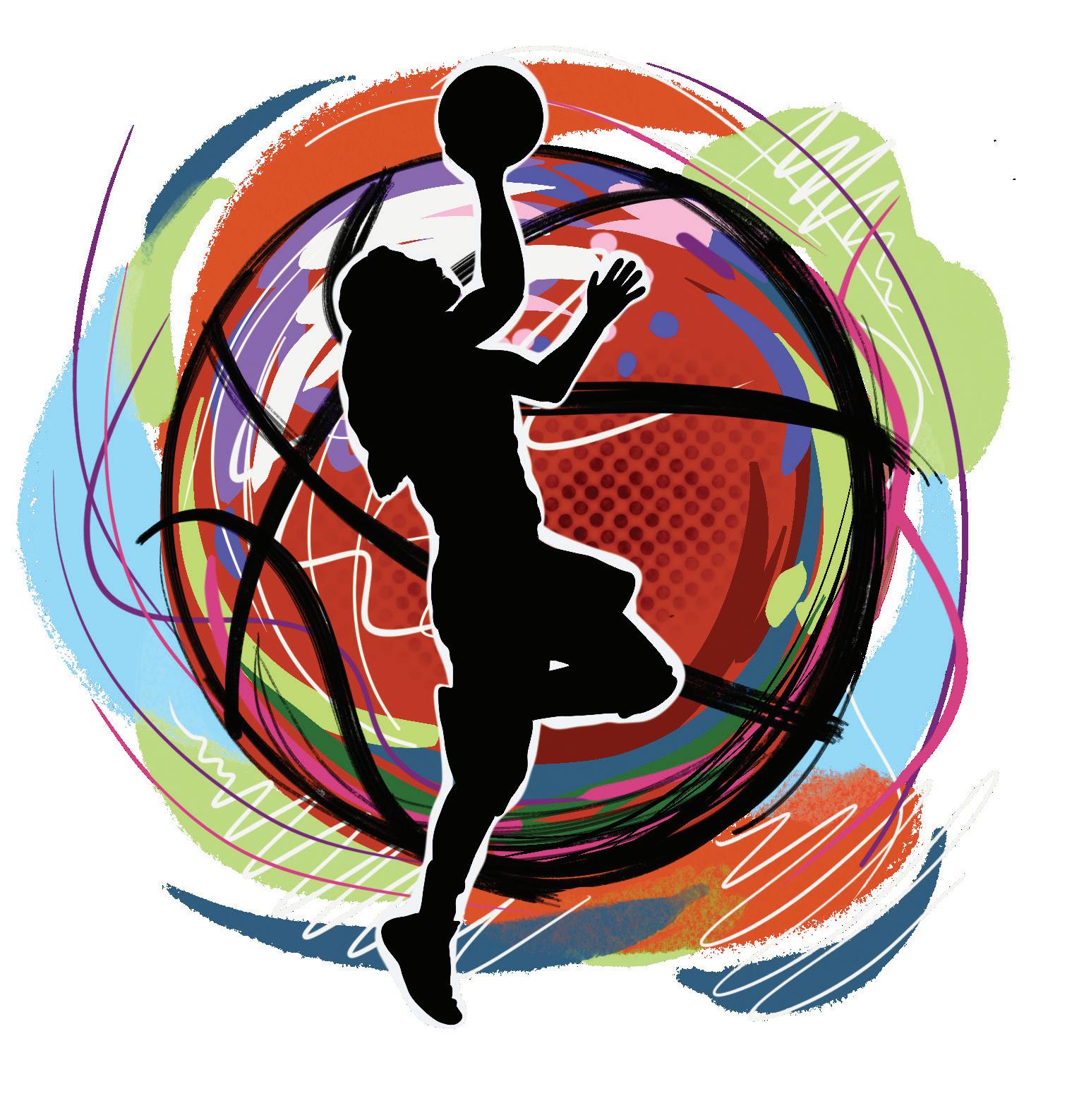
Viking Title Here Deck here Deck here Deck here Deck March 2024 Volume XVII, Issue 4 Dunking on Stereotypes March 2024 page 36
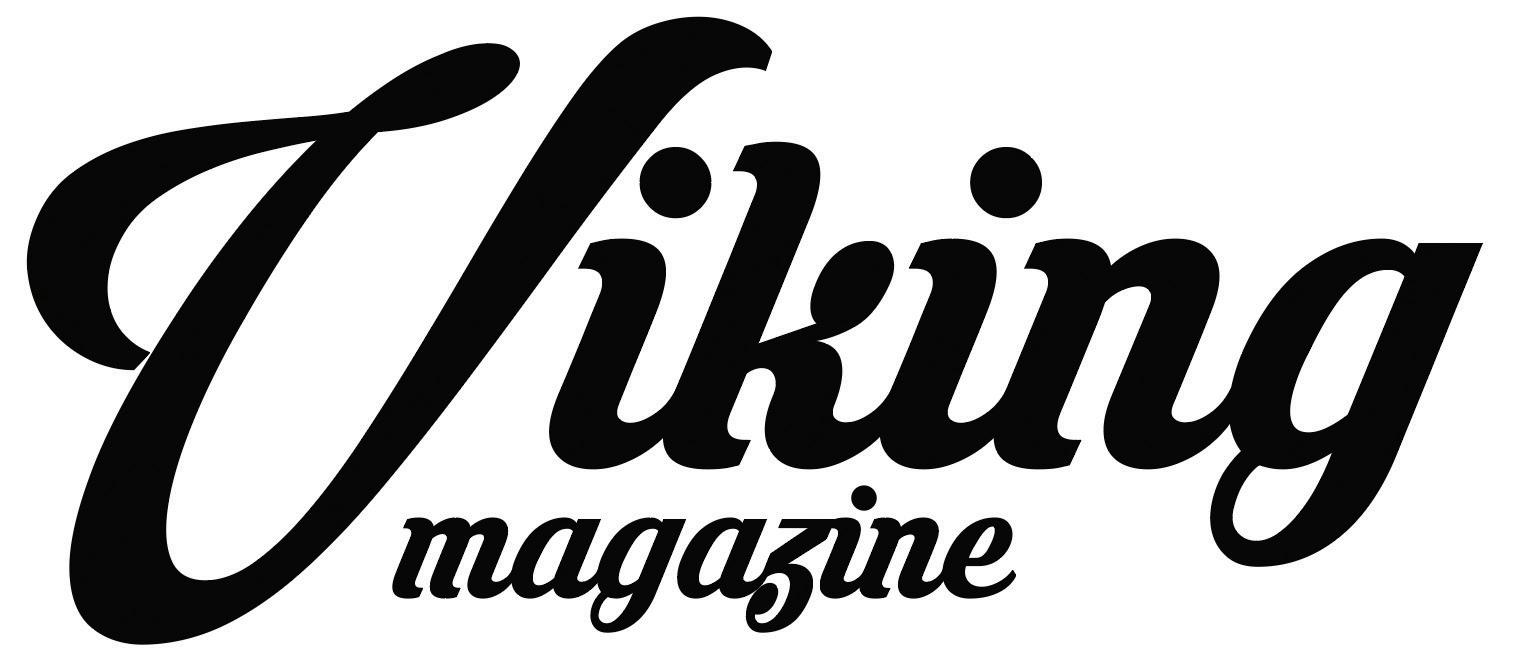
Tyler Frick, Grace Gormley, Josie Vogel
Creative Director
Eliza Gaither
Photo Editor
Jason Hu
Business Manager
Katie Yen
Copy Editor
Claire Cho

Online Editor-in-Chief
Tyler Martin
Managing Editors
Beau Revenaugh
Aspen Stitt
Head Columnist
Tyler Harrison
Social Media Managers
Trey Collins
Avery Reller
Staff Writers
Emil Bothe, Carter Burnett, Tyler Cheung, Scarlett Frick, Amanda Goody, Kamili Fossati-Moiane, Roan Haney, Luke Joachim, Nathan Lee, Ben Levav, Alena Lotterer, Max Merkel, Dylan Robinson, Evin Steele, Sarah Thieman, Lucas Tung, Jonathan Yuan
Adviser
Brian Wilson
STAFF Volume XVII, Issue 4 March 2024 Editors-in-Chief
Viking Magazine Palo Alto High School 50 Embarcadero Road Palo Alto, CA 94301 650-329-3837 Email contact: vikingeds@gmail.com Follow us @vikingsportsmag or go to vikingsportsmag.com for current game updates/scores. Viking, a sports magazine published by the students in Palo Alto High School’s Advanced Magazine Journalism class, is an open forum for student expression and the discussion of issues of concern to its readership. Viking is distributed to its readers and the student body at no cost. The staff welcomes letters to the editor, but reserves the right to edit all submissions for length, grammar, potential libel, invasion of privacy and obscenity. Advertising in Viking The staff publishes advertisements with signed contracts providing they are not deemed by the staff inappropriate for the magazine’s audience. For more information about advertising with Viking, please contact Viking by email at vikingeds@gmail.com Printing Services 2,500 copies of The Viking are printed, five times a year by Folger Graphics in Hayward, Calif. Logo Font Courtesy of Måns Grebäck
Gaither Family
Vogel Family
would like to thank our sponsors...
Collins Family
Ross
Belknap
Haney
Levav
Junowicz on the cover: This cover, with art by Grace Gormley, features a stylistic basketball and a female basketball player going for a layup in front. This feature story on the recent rise of women’s basketball can be read on page 36.
The
The
The Martin Family The Yen Family The Reller Family The Harrison Family The Steele Family The Frick Family
The
Cora
Berkley
Joanie
Jonathan
Myrna Gabbay Miranda
Sabrina Meyers (‘27) competes against Los Gatos. Photo by Grace Gormley.
Letter from the EDITORS
Hey Vikings! We are so excited to present the final issue of Viking from this editing team! We have been so honored to get to produce this magazine and distribute it to you all for this past year and we have enjoyed every second if it. We have a new team coming for our final issue, and we can’t wait to see what the next chapter of Viking will look like with them.
But for now, let’s take a look at this issue.
As always, our Zooms can be found in the beginning of the magazine on page 6, and this issue we feature baseball and swim and dive, both of which have had a stellar start to their seasons.
Next, our intro package dives into Paly’s favorite energy drinks, water bottles, and pre-game rituals that set us up for success.
Then, check out our feature on the stigma behind one of the Olympic’s newest
sports: Skateboarding.
Does your team have a team manager? Many Paly teams have fellow students who commit time and energy to help our teams run smoothly. Learn about three of them on page 18.
The issue of body image is complicated, and is even more complicated for athletes, whose bodies are a tool for them in their sport. Learn about the nuanced intersections of athletics and body image on page 20.
With the advent of the NIL, the NCAA has recently brought back their college football video game. Check out the interesting merge of e-sports and real sports on page 26.
Paly games often have creative and fun student section themes. Check out some of Paly’s favorite ones on page 28.
Sports are incredible for mental health, and many Paly athletes notice the mental health benefits of playing them. Read

STAFF OPINION
The Genius of March Madness
According to sportingnews.com, the 2015 men’s NCAA tournament averaged 9.9 million viewers per game, while regular season games broadcasted nationally only averaged 434,000 viewers.
Obviously in any sport, ratings are going to increase during the postseason. The games mean more, it’s typically better teams playing, and it’s the finale to the entire regular season. But this difference in viewership is staggering, and it’s consistent year to year.
The college basketball season starts in late November (for both men’s and women’s), and lasts all the way into mid March, before the start of the NCAA tournament. The season drags, and many fans and viewers don’t watch or care until late February or early March. But one thing is consistent, they always tune in during March. Why is this the case? How can a sport that exists throughout four months of the year only get attention during the final three weeks? The answer is simple: the brilliant structure of the
about this on page 30.
Sports gambling is illegal in California, but still many people do it, including underage Paly students. What is the loophole they’re taking advantage of, and is it putting them at risk for terrible addiction in the future? Check it out on page 32.
In our final feature and cover story on page 36, we dive into the recent rise of women’s basketball and what it means for the future of the sport.
As you can learn about on page 40, many sports have had recent rule changes. What are these new rules, and what do people think about them?
This issue in Viking Tries, we made a splash by trying diving, with D1 recruited diver and staff member Alena Lotterer showing us the ropes. Read about that (and see our scores) on page 44.
We hope you enjoy this final issue of Viking from this team. We are so proud that we got to present this magazine to you.

NCAA tournament.
The NCAA tournament contains 68 teams (with 64 qualifying for the first round) and is a single elimination bracket where every team’s goal is to win six straight games to claim a national championship.
The first brilliant aspect of the tournament is that every single conference in Division I basketball automatically gets one team into the tournament. This allows for a huge diversity of teams, due to the myriad of geographical locations, team skill levels, and fan bases all included into March Madness.
The next incredible aspect is that instead of most sports - which cater to the high seeds and do everything possible to get the best teams far in the playoffs - college basketball embraces the chaos, and holds games in neutral stadiums under unique circumstances which creates unfamiliarity, leading to many historic upsets every single season. This not only makes the tournament exciting, it makes

it wildly unpredictable.
The concept of a “bracket” was popularized with March Madness, because the tournament is so unpredictable that the odds of forecasting everything right are astronomically low. This only adds to the allure and anticipation of the tournament, as no one has ever been (and likely never will be) able to accurately predict the results from start to finish.
Finally, though chaos and madness are main themes in the tournament, history shows that it is basically always one of the best teams in the country who ends up winning the championship. This shows the skill aspect of the tournament, and how any of the top teams can win if they put it all together.
Overall, the structure of the NCAA tournament is what makes it the best sporting event of the calendar year, and it draws attention every single season in the month of March.
@vikingsportsmag | MARCH 2024 | 3
Josie Vogel
Grace Gormley
Tyler Frick
- Viking

In This Issue... In This Issue...
6 10 14 18 20 26 28 30 32 36 40 44 Zooms Intro Package Shreddin’ the Stigma Hidden MVPs Beyond the Mirror Gridiron Gaming Features in the Bleachers The Healing Game Playing the System Dunking on Stereotypes Game Changers Staff Makes a Splash
Junior James Meehan swims his leg of the 400 freestyle relay during Paly’s meet against Los Gatos on Mar 15, which both the boys and girls teams won. Photo by Grace Gormley.



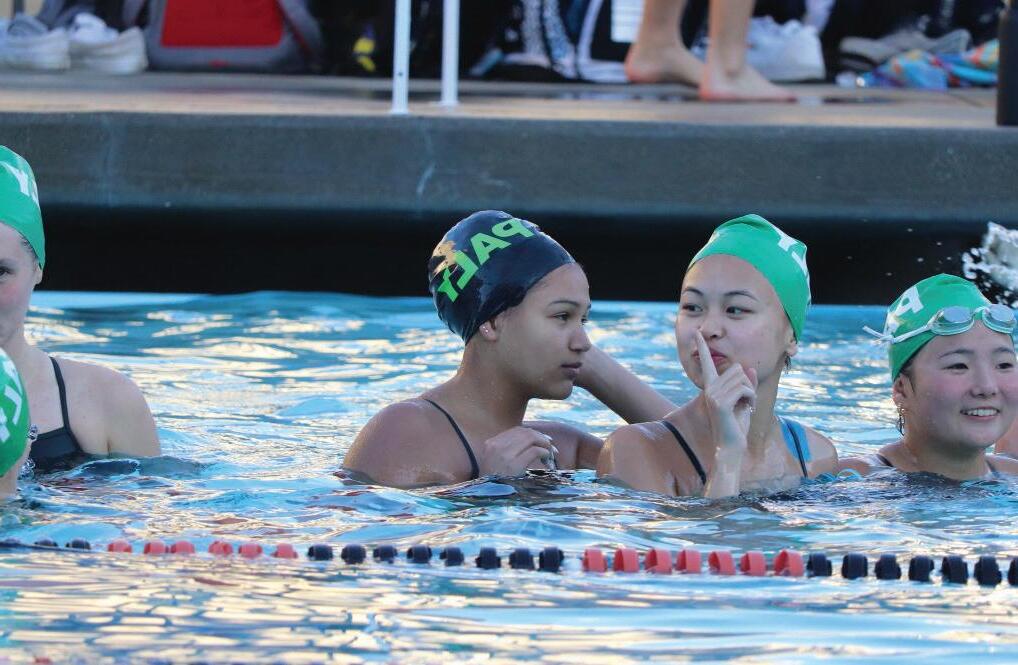
“Quiet for the Start” Kaylie Cho hushes those around her as they get ready to cheer for a teammate. Photo by Grace Gormley.

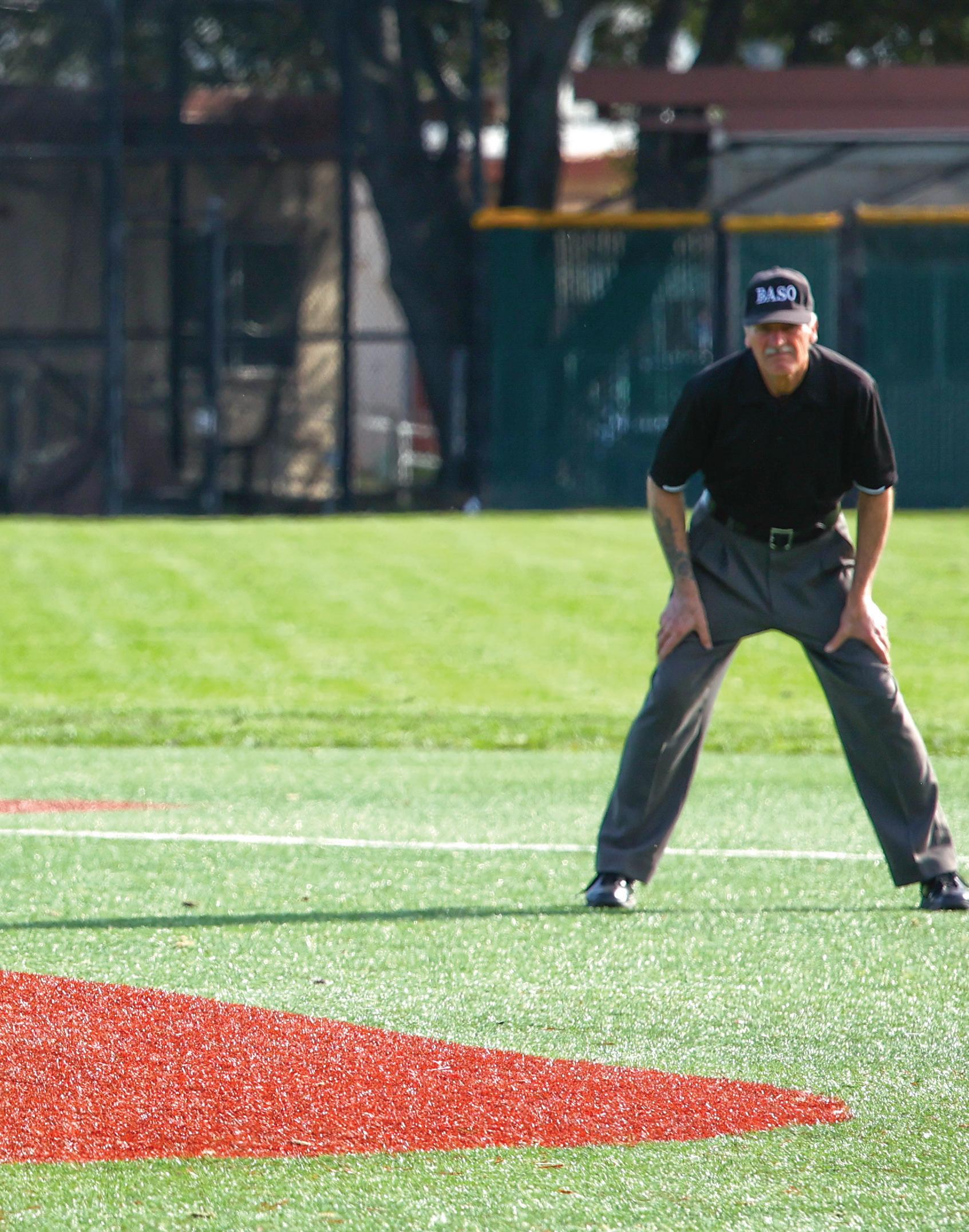
Try to
Hit THIS
Paly baseball beat Los Gatos on Wednesday
March 20, 5-0. Pictured: Senior Vinnie Braga pitches the baseball toward a Los Gatos batter.
Photo by Jason Hu

Eat My
Bubbles
Paly boys swim and dive beat Los Gatos on Friday, March 15, 103-77. The girls team also won their meet on the same day. Pictured: Senior Lachlan Kirby swims his leg of the 400 freestyle relay.
 Photo by Grace Gormley
by AMANDA GOODY and JONATHAN YUAN
Photo by Grace Gormley
by AMANDA GOODY and JONATHAN YUAN
Game Day
Pregame Rituals with Varsity Athletes
Whether you listen to music, stretch, or have a pep talk, all athletes have a pregame ritual before a big game or meet. We asked some Paly athletes how they like to get hyped before a big game.


Charlotte Barclay (‘26): Field Hockey
Q: What is a superstition that you have about pregame rituals?
A: I always put my left sock on before my right sock
Q: What is your favorite pregame snack?
A: A turkey sandwich or Welch’s fruit snacks
Q: What is your pregame ritual?
A: I listen to the same songs

Alec Bonnard (‘25): Soccer
Q: What is a superstition that you have about pregame rituals?
A: Wearing a pair of red socks


Q: What is your favorite pregame snack?
A: I like to eat a banana before a game
Q: What is your pregame ritual?
A: Using the restroom
Katie Spitzer (‘25): Water Polo
A: Z-Bars and Vitamin Water
Q: What is your favorite pregame snack? Q: What is a superstition that you have about pregame rituals?
A: I like to visualize my plays
Q: What is your pregame ritual?
A: Warm up and stay active


FUELING YOUR FITNESS
by AMANDA GOODY and JONATHAN YUAN
Before doing a big workout, it is important to make sure that your body has the energy it needs to perform properly. Pre-workout comes in many different forms; some may prefer liquid energy as opposed to the standard pre-workout powder. We were curious to learn the pre-workout preferences of Paly students before a big lift, game, or practice.
Question: What is your favorite pre-workout?
“My favorite pre-workout is probably Alani Nu Cherry energy drinks because they make me feel energized before my workout.
- Ella Sherlock (‘25)

“I love Peach Vibe Celsius because they taste fantastic and they get me very hype before I play a game.”
- Maeva Herbert Paz (‘26)


“My favorite pre-workout energy is a Mango Passionfruit Celsius because I like the passion fruit flavor.”
—Bella January (‘26)

“Preworkout tastes bad and it’s inconvenient. Gatorade is just an all time classic.”
- Meryem Orazova (‘26)
by AMANDA GOODY and JONATHAN YUAN
WINNING with Waterbottles
Many athletes disregard the importance of good water bottles, while others do have a preference. Below are some of the Paly swim team’s favorite brands of bottles.
Q: What water bottle do you use for swim practice?
“I use a 24 oz Tervis bottle because it keeps my water cold.”
- James Meehan (‘25)



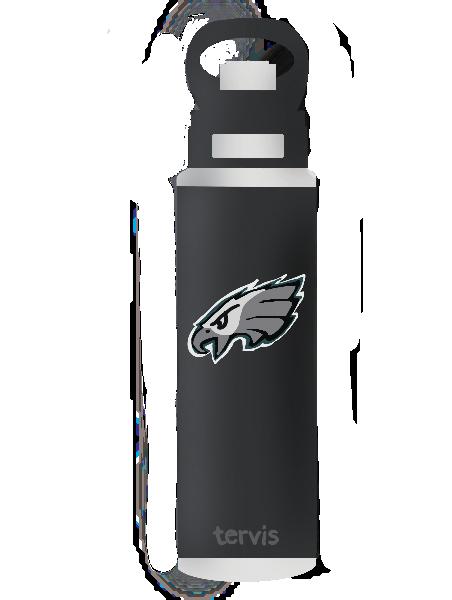
“I use a Hydro Flask. I like it because it keeps my water cold during practices and meets.”
- Romy Kirby (‘26)

“I use a 40 oz Thermoflask. It’s good because it keeps my water cold and holds enough water to last an entire practice.”

- Blake Wang (‘25)
“I like to use a 32 oz Gatorade bottle because I can just squirt water into my mouth and the water is very easily accessible.”
- Nico Ogawa (‘25)




“I use a 40 oz Stanley because the straw is very convenient so when I am stopped at the wall I can take a sip quickly.”
- Fallon Porter (‘26)

@vikingsportsmag | MARCH 2024 | 13



















 text and design by EMIL BOTHE, TREY COLLINS, and EVIN STEELE
text and design by EMIL BOTHE, TREY COLLINS, and EVIN STEELE
Throughout the past few decades, skateboarding has earned a negative connotation due to stereotypes surrounding the participants and their lifestyles. With the addition of skateboarding to the 2020 Olympics, skateboarding started to be seen as a legitimate sport and the community around it has gained respect as well. Is the Bay Area skate culture changing in the same way?
Skateboarding is a sport enjoyed by many Paly students. It’s more than just a sport though; with a strong community, unique fashion, and youthful vibe skating attracts a variety of people that don’t aren’t enticed by mainstream sports. The creativity and individuality are certainly attractive.
ers. In high school movies, skateboarders are often unfairly painted as drug users, bad students, and soon-to-be dropouts.

“I love pushing [myself] fear wise. If you’re really scared and you go for it, it feels great”
Unfortunately for skateboarders, the sport has the perception of being an activity for delinquents and troublemak-

-Keshav Srinivasan ‘25
In addition, graffiti that often covers skate parks, as well as the dark baggy clothes usually associated with skateboarders, creates a negative image for bystanders. Graffiti is considered vandalism, and the baggy clothes give the perception that the sport is stuck in the ‘90s. Junior Keshav Srinivasan is a skateboarder who has encountered these stereotypes.
“Because of the baggy pants, like when


 Photo courtesy of Keshuv Srinivasan
Photo courtesy of Keshuv Srinivasan
[I’m] sagging a lit tle bit, people will look at [me] dif ferently, especial ly old people,” Srinivasan said. “People will be really mad when we’re just there, and I think that comes from the stigma around skateboarding.”

“Skateboarders have always had a reputation for not having any ambition, it has been nice to change that overtime”
-Shina Eron ‘25
Skateboarding is a public sport, done both in and outside parks. Aside from skate parks, skateboarders will also go out and find special spots to practice certain tricks, such as specific rails or edges that aren’t available at the park. However, sometimes these spots can be very close to businesses or other private properties, which causes conflict between the skaters and the owners.
“[In front of stores] they have [handrails], so we’ll go out there and skate the rail,” Srinivasan said. “It’s not the best thing to do, but it’s not really hurting anyone.”
Skating in places that aren’t designated skate parks will enrage people though.
portray the sport in the best light. However, this is just a small downside, and skateboarders like Srinivasan want to show the positive and exciting side of skateboarding that is often not seen by the public.
“I love the process of learning new tricks. I love the feeling you get when you
ent skate parks you meet a lot of new people.”
More experienced riders in the skate community also help make new skaters feel comfortable and welcome.
“Everyone is really supportive of each other,” Saleh said. “Whether you’re trying a new trick or doing anything really, people are very friendly.”
Another big upside is that skateboarding is an individual sport, and so skateboarders can constantly be outside and active without needing others around. Even though the community is such an important part of skateboarding, at the end of the day all a skateboarder needs is their board. Gunn junior Shina Eron is a member of the skating culture, and was

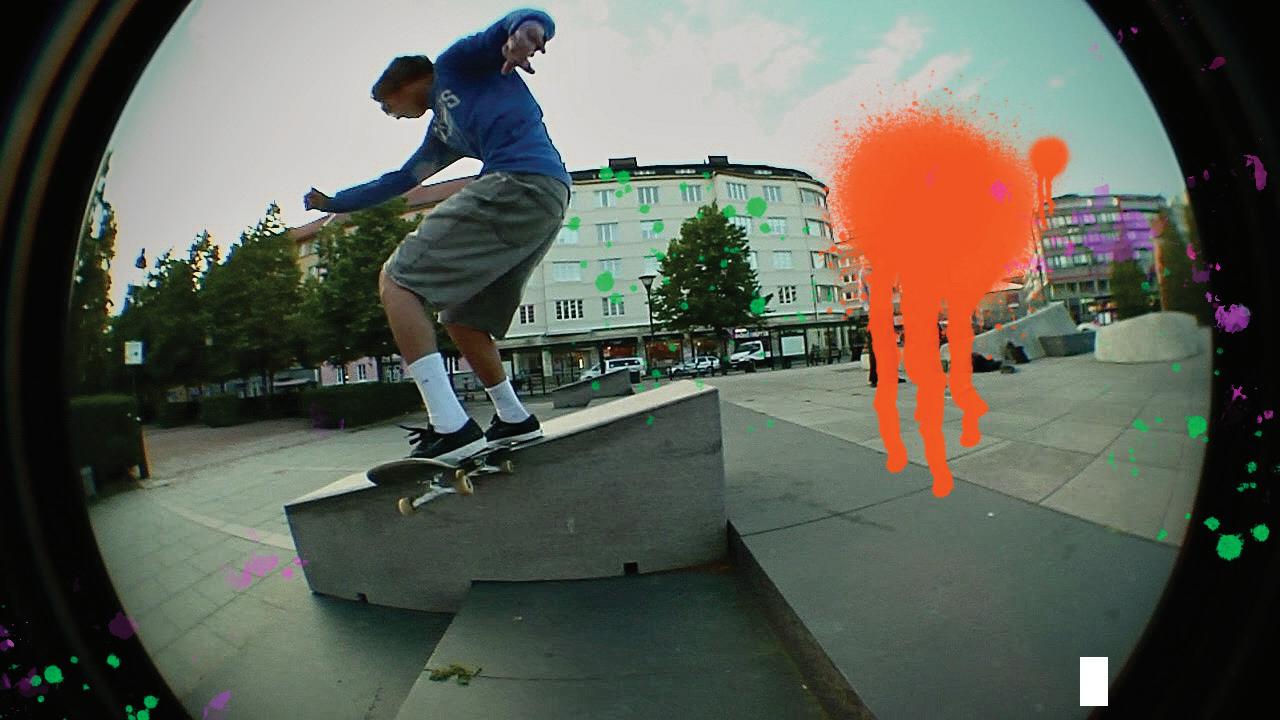
“Sometimes the people that will kick you out can just be [rude],” he said. “[They’ll threaten] to call the cops and be super annoyed. They’ll be coming up and yelling when the easier approach is to just say ‘I’m sorry but you guys can’t be here.’”
These unpleasant situations do happen from time to time, and certainly don’t

land a new trick you’ve been battling for a long time. I love pushing yourself fearwise. If you’re really scared and you go for it, it feels great,” Srinivasan said. Junior Christian Saleh has found a strong community in skateboarding.
“I love how many friends and new people you meet through skateboarding,” Saleh said. “Just going around to differ-
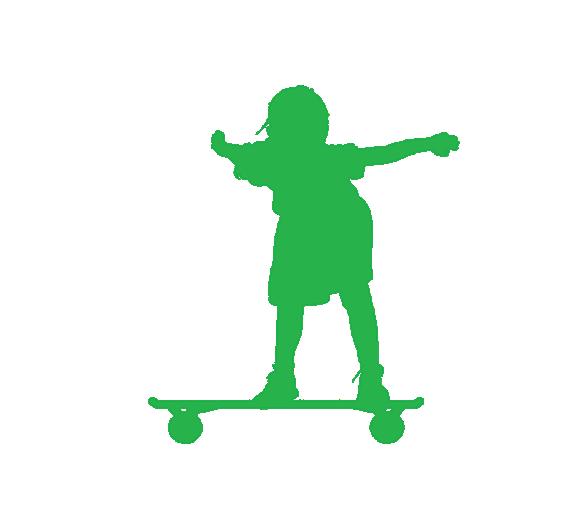
attracted by the individuality of it.
“Skateboarding is an outlet for me,” Eron said. “It’s a personal sport because you are in charge of what you want to do. You can go to parks around the Bay, you can skate on any flat surface, and you can even build your own park.”
Eron is a girl in a male-dominated sport, which has given her a unique experience


@vikingsportsmag | MARCH 2024 | 15
Photo courtesy of Keshuv Srinivasan
with the skating culture.
“It’s intimidating at first, but I found a community with other girls who [also skateboarded],”
Eron said. “We have a special bond and go out of our way to skate with one another.”
Through this bonded community, it is also inevitable that a strong passion is built for skateboarding. For Menlo-Atherton senior James Polly, skateboarding quickly turned from just one small aspect of his life to an outlet for him to express himself creatively. Through film, one such creative aspect, Polly has found a new spark in life.

Menlo Park. Hundreds of people came to watch,” Polly said. “It was one of the most rewarding and joyful experiences in my life.”
“Skateboarding being added to the Olympics has added a sense of legitimacy we have lacked for decades”
-Keshav Srinivasan ‘25
After his premiere, Polly went back to his regular filming routine. What he didn’t know though is that his “hobby” was about to open up a whole new range of opportunities.
“We began working on a second film when I was introduced to a short film
competition at my school,” Polly said. “I never thought that the filming I was doing for skateboarding would actually transfer into another part of my life, I was just doing it for fun originally.”
He began working for hours on hours, perfecting his work and ultimately finishing his film for the competition.
“We had gone on such a journey throughout the filming process, I ended up learning so much about myself and my creative preferences,” Polly said.
When Polly finished his film he ended up winning first prize for cinematography in the short film contest.
“When I got first place, it was so validating, I thought to myself ‘like oh wow, this is real’ which inspired me to continue working on my film,” Polly said.
“When me and my friends were skating, we wanted to film our tricks in the best way possible,” Polly said. “I began to film whole days; our trips to the park [as well as] the community that revolved around the park.”
For Polly, filming became an obsession beyond just documenting his tricks. He was acquiring hours of footage from his filming and wanted to compile them into a big film that represented him and his friends. He wanted to showcase their journey of skateboarding as well as document the joys and mystique of adolescents.
miere in a huge bowl in




Polly built up his portfolio over the next few months, applying for the New York Times cinematography program.
“I kind of just applied; getting in was what was truly shocking to me,” Polly said.
When Polly got to New York, he was exposed to a whole new approach to filmmaking. As well as a whole new community that shared his passion for cinematography.
“It was definitely a learning experience to understand and fuse so many different techniques into my filming that I had never thought of before. I was stubborn at first for sure, but ultimately realized that the new techniques gave me new ways to share ideas.” Polly said.
After Polly finished his summer program his portfolio was extensive, just in time for college applications. Polly ended up applying to New York University in Manhattan, pursuing a film degree. He was accepted and will be a freshman this coming fall.
“My filming journey was definitely unusual compared to most of my filming peers, but
 The premier of Polly’s film in Menlo Park. Photo courtesy of James Polly
The premier of Polly’s film in Menlo Park. Photo courtesy of James Polly
I think that getting here through skateboarding has been really important in shaping the way I create my art,” Polly said.
A major step in breaking down the stigma around skateboarding is the sport’s advancement on the world stage. With skateboarding’s recent addition to the Olympics, it is now recognized as the most prestigious sporting competition in the world.
The process of getting that recognition was not easy however, as the sport is considered a high injury risk (a liability the Olympic committee doesn’t usually want to take), and there is a large pushback from skaters with traditional skateboarding values (skating has always been viewed as a niche sport, and many didn’t want that to change). However, support from the professional skateboarding community as well as an increase in the sport’s popularity helped overcome these challenges.
ming or track and field.”
At the moment skateboarding is relatively new to the international stage, but over the coming years, it should contin-

ue to develop into a full-blown professional sport. According to SkyQuest, the global skateboarding market is projected to grow from USD 2.83 billion in 2022 to USD 4.16 billion by 2030.
not over, skateboarding has come a long way. People are starting to see that the sport is more than just “bums” with nothing better to do, and instead, as a way to show creativity, style, and fearlessness in both recreational and competitive settings. Perhaps most importantly, the skateboarding community is a unique one, where skateboarders can form lifelong friendships with people from all ages and backgrounds.
“Skateboarding has become one of the most important parts of my life, and I wouldn’t have it any other way,” Srinivasan said. “It’s impacted me in so many different ways, and I wouldn’t be the same without it.”
In 2015, skateboarding was added to a shortlist along with five other sports to possibly be introduced in the 2020 Summer Olympics. A year later, skateboarding was approved to make its Olympic debut in the 2020 games.
“Parents won’t be able to say anymore that their kids are wasting their future by skateboarding,” Hiremath said. “Now skateboarding is on the same level as universally recognized sports like swim-

“A lot of people feel that skate boarding can’t become a real career,” Hiremath said. “But I think we’ll start to see skateboarders making money through brand deals and other methods, and then skateboarding could turn into something that kids can dream to do for their whole lives.”
Although the battle against the stigma around skateboarding is certainly

“Through skateboarding, I have been introduced to an immense field of creative outlets that have inspired my future career”
-James Polly



@vikingsportsmag | MARCH 2024 | 17
Photo courtesy of James Polly
by BEN LEVAV AND
THE HIDDEN MVP MVP

In the world of sports, our team managers are often the unsung heroes. These fellow high schoolers’ dedication and hard work are the glue that holds their team together. To share more about it, three Paly team managers discuss their experiences with the job.
Q Q Q 1 2 3

How does your job provide fullfilment for you?
What is your biggest challenge in the role?
What is your favorite memory as team manager?

Anne Threlkeld
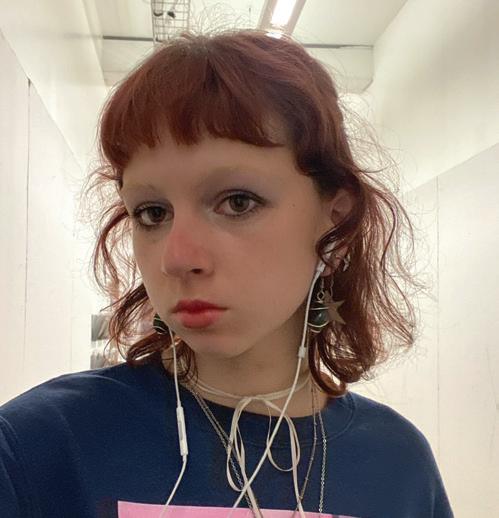
Olive Lindstrom

Kyle Clark
Senior, team manager of the Paly swim and dive team
Senior, team manager of the Paly swim and dive team
Senior, team manager of the Paly basketball
18 | VIKING MAGAZINE | vikingsportsmag.com

A A A 1 2 3 A A A 1 2 3
I grew up swimming and it has been an enourmous part of my identity throughout my life. I had some mental and physical health struggles that interfered with swimming, so I had to stop junior year. I really wanted to stay in the environment and help the team in any way I could.
The biggest challenge is meeting the needs of the coaches, parents, swimmers, all at the same time, and kind of being a communication liaison between everyone. My favorite memories have been at meets when one person is trying to make a [CCS qualifying] cut and the entire team bands together to support that. I remember one meet last year when an athlete was going for CCS in the 500 freestyle and his team mates in his heat were pacing him and everyone else on the team was up there cheer ing on the deck.

Anne Threlkeld Olive Lindstrom
For me, I really wanted to focus on my art and to do so I needed to take a step back from swimming unfortunately. I chose to be a team manager last year because I real ly still wanted to be somewhat part of the team.
I didn’t really find the role itself to be challenging, but I think my biggest struggle was just not being a part of the team itself and losing that very big part of my life.
Definitely meets, as well as post-meet dinners at Town and Country. These moments were where we really bonded as a team; through the different grades we were able to form really strong connections through our love of the sport.

Kyle Clark
I don’t need a Paly jersey to define my role in the team, but the effort and time I’ve given will surely be in the hearts and minds of the players and coaches I’ve served alongside. That is fulfilling enough.
Time managements is one of the hardships of being a manager. I woild sometimes find myself juggling between school and practice or games. It’s basically being like a stu dent-athlete but with less athleticism. And it’s definitely a valuable skill that would come in handy, and I’m still in the process of mastering it.
The best one would be our 55-39 win against Mountain View ... We were in the locker room with everybody hyped over the win. Coach Lamere starts to ask the players what they have to say ... I didn’t know what to say but with my lungs full, I shouted, “Coach, I love this team!” It was a joyous moment, and I’ll never forget it.
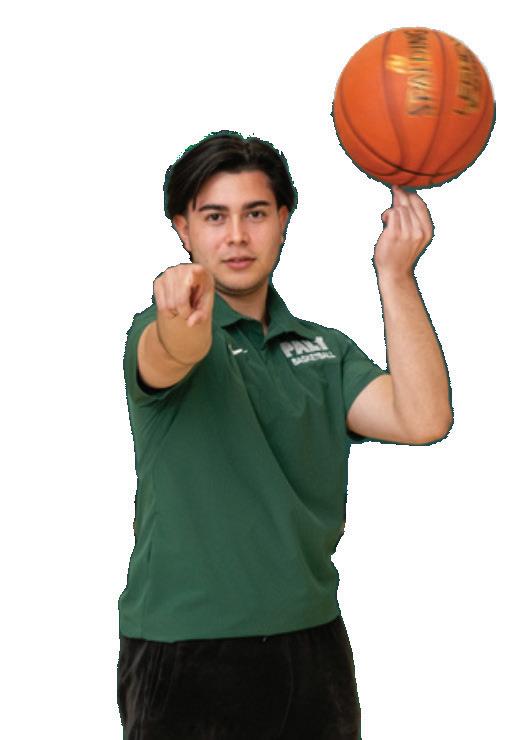
@vikingsportsmag | MARCH 2024 | 19
by ELIZA GAITHER, SARAH THIEMAN and KATIE YEN
Beyond the Mirror
Every human has a unique experience with how they relate to their own body, but for athletes, their experiences in their sport and their daily life often creates a more complicated relationship. Do sports inspire body confidence, or can they exacerbate self esteem issues?
Behind every hurdle, tackle, throw, kick, stunt or plié is an athlete looking in the mirror at a person who feels they should have a certain physical look. Our Paly athletes have the mental endurance to show up for their sport every day, and more importantly, show up for themselves. The power of resilience and growth may be either diminished or improved by the way athletes feel in their skin.
Body image is defined as the multidimensional and dynamic concept that encompasses a person’s perception, thoughts, and feelings about their body.
Athletes across the world can be mentally and physically pushed to reach
as “not feminine enough,” and lean male athletes might be “too small.” Regardless of these examples, there are countless other standards placed on all athletes that can not only impact their ability to perform but also their mental capabilities.
It is essential to know the difference between working hard to be strong and agile and working to achieve a certain look. Body image issues are commonly overlooked, but even more so is the hyperfixation athletes have around nutrition to maintain a certain image.
Paly athletes were asked about their experience with the topic of body image within the community of sport(s) they play. Olivia* is a senior who participates
“Much of the commentary can lead to mental health problems, such as anxiety, depression, imposter syndrome and eating disorders,”
- Emma,* Paly Student
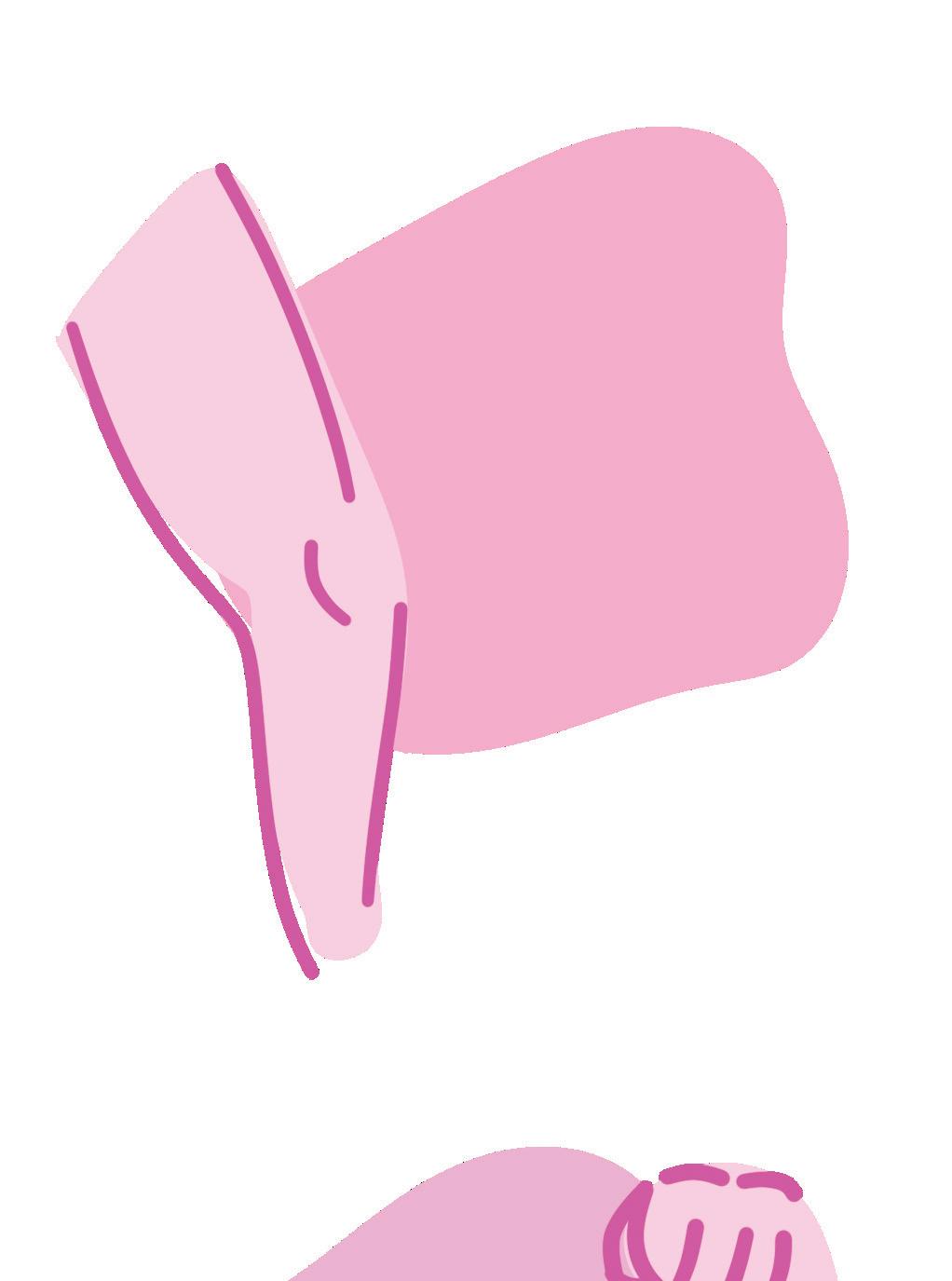
discouraged and insecure, which causes me to lose confidence in the sport.”
This lack of confidence can also be associated with an increase in mental illnesses for some athletes. Emma*, another Paly student who participates in dance, notes a similar phenomenon.
“Many ballet dancers who have been a healthy weight have been told that they are too heavy,” Emma said. “Much of the commentary can lead to mental health problems, such as anxiety, depression, imposter syndrome and eating disorders”
When an audience sees a beautiful dancer on stage, with strong, lean muscles and perfect balance, they might not take into consideration the amount of mental pressure put on these athletes. It is essential to understand that with any sport there is a possibility to develop different forms of stress, but dance is one of the most common sports to lead to eating disorders.

The top priority in sports like dance is to celebrate lean athletes who have the stereotypical build of a dancer, which can create an environment where there is little to no body positivity expressed. Body image dissatisfaction can be directly related to unhealthy behaviors like frequent dieting, bulimia, extreme restrictive eating, and a lack of confidence in their performance.
One professional ballerina, Kathryn Morgan, is dedicated to trying to change the unrealistic body standard in dance. A soloist at the Miami City Ballet, she was cut from performing a solo titled “Firebird” because of her size.
I put the clip of Firebird in there to
20 | VIKING MAGAZINE | vikingsportsmag.com
show the reality of the situation,” Morgan said in an interview with Dance Magazine. “My clothes hanging in my closet are size two and zero and extra small and I am considered a large size. I wanted to show people this is what I look like. This is the reality.”
One of the most common claims used to justify the body standard of ballet and dance in general is that directors have an artistic vision, and that that vision includes smaller women. Morgan, however, feels that these standards are
Charlotte* expressed that her body image changed depending on who she surrounded herself with.
“I grew up playing a sport where being taller is an advantage and I am generally pretty tall,” Charlotte said. “I feel less selfconscious around my teammates who have similar heights than when I am with my 5-feet tall, 100 pound friends.”
This is not an uncommon situation for athletes, especially women, to have a different body image within their sport and when
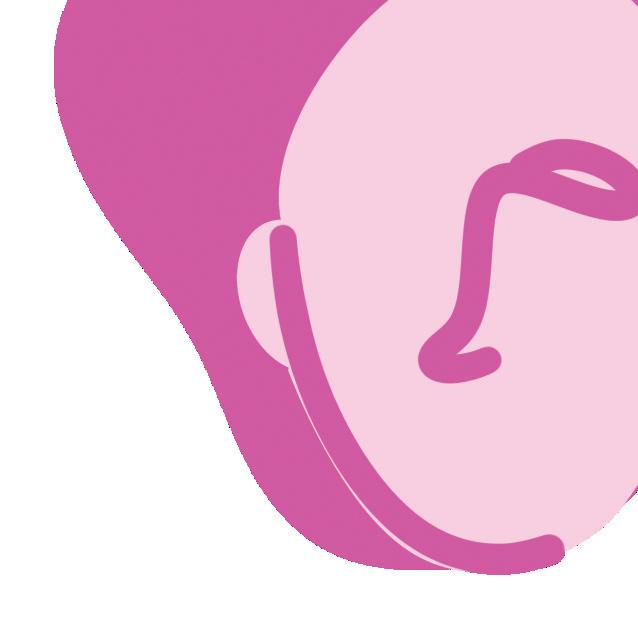
they are in public. In the article, “Global Sport Matters: Body Image Issues,” published in 2019, Dr. Erin Rubenking highlighted “In sports, [an athlete’s body] can be totally normal, and they feel proud of themselves, but then sometimes outside of sports, depending on the athlete, that’s when they begin to feel more self-conscious.”
Part of this may come from the fact that sports focuses more on what the body can do, not how it looks. Sophia*, a Paly swimmer, notices that this impacts her

“In sports, [an athlete’s body] can be totally normal, and they feel proud of themselves, but then sometimes outside of sports, depending on the athlete, that’s when they begin to feel more self-conscious,”
- Global Sport Matters: Body Image Issues (2019)
“I remind myself that the sport has taught me lifelong lessons about fitness and exercise, so it’s not much of a worry to feel different,”
- Maddie Lee ‘25

One thing that can help support a good relationship with one’s body is participating in a sport in which many different athletes can find success.
Swimming is a sport that requires physical strength and endurance, but there is no “right” look for these impressive athletes.
Sophia*, a swimmer, feels that the sport has a representation of all people.
“Swimmers come in many different sizes and

demanding and time-consuming sport, often assumed to have specific physical criteria.
“Rowing has improved my body image because I look toned and feel healthier, but it also has left me feeling ‘too muscular’ or wanting to be smaller,” Lee said.
Despite some challenges about wanting to fit into a certain body type, Lee recognizes that rowing has given her so many benefits.
“I remind myself that the sport has taught me lifelong lessons about fitness and exercise, so it’s not much of a worry to feel different,” Lee said.
Lee hits on an important point that, though sports can improve body image by actually changing the composition of one’s body, whether

physically
gaining muscle or losing weight from working out and training, participating in sports can also improve body image regardless of if your body changes at all.
By building a good relationship with working out, especially if surrounded by other athletes all with different body types, your own body image can improve as your confidence rises and you take advantage of your body’s feelgood hormones during training. Along with that, the mental health benefits that come along with exercise can improve negative emotions surrounding all aspects of one’s life, some of which might include body image issues.
Along with being content with their physical appearance, athletes might find that sports influence them to eat balanced meals and snacks throughout the day as essential benefits to their performance. Athletics can promote healthy nutrition and a balance of all essential foods rather than solely focusing on the way one looks, sports teach athletes to fuel themselves. In addition to his rigorous workouts for his sport, 11th-grade student Liam* understands what he needs to do between his training hours.
otherwise known as “happy hormones,” released during workouts leads a lot of athletes, including Sengupta, to find body confidence.
Studies have proven that there are mental benefits of exercise on a neurochemical basis. These benefits include an increase in dopamine levels in the brain, which decreases stress and even depression due to the enhancement of those “feel-good” transmitters. Not only are hormones released, but exercise also reduces levels of the body’s stress hormones, such as adrenaline and cortisol.
“Sports make you feel and become healthier, which is a huge aspect of self-confidence

“Food is so essential for athletes before and after practice, especially young athletes,” Liam* said. “No matter what, all categories of food should be on the table, meaning fats, proteins, and carbs.”
Those athletes who do prioritize nutrition might also find their body image to be more positive since getting the right nutrients can improve sleep and mood overall.
Paly junior Rohit Sengupta, a mountain biker and tennis player, has effectively improved his mindset through training.
“Mountain biking and tennis both improve cardiovascular health, strength, and endurance, leading to a better physique and a more bulky look,” Sengupta said. “The physical benefits combined with the mental boost from endorphins and skill mastery contribute to a positive body image and self-esteem.”
Sengupta has learned to focus more on physical fitness and improved mood rather than the way he looks.
The rush of endorphins,


As stated by the National Institutes of Health, hormonal fluctuations during adolescence alter brain function, heightening self-awareness and sensitivity to one’s surroundings. This heightened awareness, coupled with rapid physical changes and the societal pressure to conform to new standards of appearance renders teenagers particularly susceptible to developing eating disorders and experiencing dissatisfaction with their bodies. The “Spotlight Effect,” or the idea that everyone is focusing on you and your flaws, is particularly common among adolescents and can contribute to a lower self-image.
However, engagement in exercise and sports offers a valuable avenue for managing these hormonal shifts. For Sengupta, as well as countless other students at Paly and athletes worldwide, participation in athletics serves as a crucial tool for regulating hormonal balance and fostering a positive body image. Recognizing the powerful impact of sports on body image is essential in supporting the well-being of adolescents navigating this challenging and pivotal stage of development.
Paly sophomore Estelle Dufour, a water polo player and swimmer, has found sports to contribute positively towards body image.
“Sports make you feel and become

healthier, which is a huge aspect of selfconfidence and body image,” Dufour said. “Personally, feeling healthy and fit improves my body image and how I feel.”
In a study titled “The Impact of Sports Involvement on Body Image Perception and Ideals: A Systematic Review and Meta-Analysis,” it is concluded that participation in sports improves the perception and acceptance of one’s body image, which has been demonstrated and compared to the non-sports population. Through the study, it has been proven that athletes are generally believed to be more satisfied with their bodies. However, based on 15 studies reviewed, there is a greater body image dissatisfaction (BID) in female athletes than in male athletes.
Although this data aligns with the widely accepted notion that men and boys are less susceptible to body image dissatisfaction and the abundance of disorders that accompany poor body image, Paly 9th grader Oliver* provides his two cents on why this might be and his experience with body image.
“There is a dangerous stigma around male body image and this has caused me and probably other boys to shy away from expressing these stereotypically ‘female’ insecurities,” Oliver said.
Oliver wants to highlight that men and
@vikingsportsmag | MARCH 2024 | 23
“There is a dangerous stigma around male body image and this has caused me and probably other boys to shy away from expressing these stereotypically ‘female’ insecurities”
- Oliver*, ‘27

boys can struggle with body image as well. In the future, perhaps movements online that are typically geared towards women, like body positivity, can be accepting to men who wish to express their insecurities.
According to “The Body Project” published by Bradley University, “Men tend to be quieter about their body negativity, seeking treatment less frequently or holding off on treatment longer than women due to shame (Brennan, Lalonde, & Bain 2010; Burlew & Shurts 2013).”
Oliver also highlights the difference between his experience with body image and the public perception of male body dissatisfaction.
“I feel like the male body image tends to be misunderstood,” Oliver said. “I feel like a lot of people presume that we are only concerned with perceived lack of muscle when I feel like it’s much more complex than that.”
In the same way that some women might want to be thinner, but others want to have more muscle, be taller, or even gain weight or curves, men also have complex relationships with their bodies, but these nuances are often glossed over.
These differences and complexities of how each gender relates to negative
body image are important when it comes to recognizing the stigma for male athletes. Society must turn attention to male body image just as much as we validate and seek to make it positive for women. Nevertheless, the issue is ongoing and impacts all athletes, regardless of sex.
One way to combat negativity around body image is body neutrality, a rising mentality to help all people feel comfortable in their skin. Paly student 10th grader Ava* understands the idea of body neutrality, which differs from body positivity, and simply describes prioritizing a healthy and functioning body rather than an outside appearance.
“My body does what it’s supposed to, so I try to be thankful for that and put aside the visual aspects of it,” Ava said.
Due to the Body Positivity movement, an online movement that was created to help serve as an appreciation of all parts of one’s body (founded in reaction to the “Heroin-chic” eras venerating extreme thinness of the 90’s and the 00’s), many people can find confidence and joy in their body, despite insecurities. But, while body positivity may help some, it can be harmful to promote constant unconditional self-love and has even become toxic, at times promoting unhealthy eating by comparing keeping a healthy and balanced diet to dangerous conditions like eating disorders.
It is both unrealistic and ineffective to expect unabating appreciation for every inch of one’s body. Instead of taking energy to always love your body, a much more comfortable and attainable goal promoted by body neutrality is finding peace with it; not being enamored with your appearance all the time, but overcoming insecurities and not dwelling on them.
“It’s unrealistic to always absolutely love what I see in the mirror, but I also realize that it shouldn’t be normalized to dislike what I see,” Ava said. “I honestly feel pretty opposed to my body.”
Something that might deter athletes from delving into the “body neutrality” mindset is the notorious issues within social media platforms.


Social media has been a major contributor to body image struggles by creating unrealistic beauty standards and encouraging insecurities. It has managed to turn natural components of the human body into new things to be insecure about. While some view sharing your insecurities as helpful, by showing those with the same insecurities that they are not alone, it also can create new insecurities in others. As various trends emerge and fade, people can feel constant dissatisfaction with their bodies.
Pressure to fit these standards is overwhelming, especially with the rise in editing platforms. Filters, photoshop, plastic surgery and other tools contribute to creating idealized versions of beauty. Constant exposure to photos or videos online that are carefully curated and edited sets an unreachable benchmark and fails to accurately portray reality. If creators are not honest about how they portray themselves on social media, it can leave dismayed followers wondering, “Why haven’t I grown up to be perfect like this celebrity has?” Social media facilitates a comparison culture that causes others to develop low selfesteem and feelings of inadequacy when they see others’ seemingly “perfect” bodies. Paly sophomore and water polo player Maeva Herbert-Paz highlights what she notices from her experience on social media.
“There are so many people to compare yourself to online, and a lot of competition online in general,” Herbert-Paz said. “Genetics play a big role in different body types, and people can create unrealistic beauty standards by posting their body on social media, causing other people
24 | VIKING MAGAZINE | vikingsportsmag.com
to compare themselves to a body even when no matter how hard you work you won’t be able to achieve that body type.”
Someone may open a social media platform and see dozens of photos or videos from fashion models, influencers, fitness models, or other athletes and feel pressured to match their physical appearance, causing them to set unsustainable and unhealthy goals as an athlete. Paly junior and gymnast Svina Narang adds to how the media can add pressure to athletes and their performance.
“Unrealistic standards set in the media are harmful for many athletes, and even standards set for gymnasts, in particular, to look ‘strong enough,’ for example, have a really negative effect on gymnasts,” Narang said.
Social media can also spread false information about what is healthy and unhealthy, especially regarding nutrition. It is easy for athletes to take advice without doing further research after hearing information online.
However, it isn’t all bad. Social media has many benefits in promoting positive ideas about body image. Social media creates an outlet for well-known, influential athletes to share their everyday life, causing others to feel more comfortable about themselves and normalize healthy habits. Other encouraging content like fitness advice, community support, and education is also prevalent across media platforms.
“Social media can
bring more awareness to disordered eating and what a healthy body can look like as well,” Herbert-Paz said. “It’s a good way to spread information about body image and healthy eating.”
Additionally, when used positively, social media can contribute to a more inclusive and diverse representation of all body types. Influencers can help promote unique features and alternative beauty standards that both celebrates the beauty in differences and combats
traditional beauty standards. Through seeing successful athletes or anyone with a familiar body type, athletes might find comfort and reassurance in themselves to help feel more comfortable in their own skin.
There are countless complex correlations between body and mind for athletes, of both positive and negative dimensions. A positive body image can empower athletes to excel in their sport and personal lives, while a negative body image can deter athletes from their athletics. Fostering confidence and embracing the body diversity within sports is essential to making sports more inclusive for all.
“Unrealistic standards set in the media are harmful for many athletes, and even standards set for gymnasts, in particular, to look ‘strong enough,’ for example, have a really negative effect on gymnasts,”
- Svina Narang, ‘25
It is essential to push back against the superficial factors of sports, and consider each body to have a physical rather than visual purpose. Your body isn’t an ornament, but rather a tool to maintain and utilize.
* Names with an asterisk have been made anonymous at the request of the interviewee using the most common names in the US.


@vikingsportsmag | MARCH 2024 | 25
by LUCAS TUNG and TYLER CHUNG
Gaming Grid
Despite being out of commission for almost a decade, EA’s College Football video game is making a return. What will this new game look like, and what does it mean for the future of football video games?
On February 15, EA’s College Football 2025 was announced. The last iteration of the game – NCAA Football 14 – is considered one of the greatest sports video games of all time. The teams, the players, the gameplay and the nostalgic factor are reasons why the legacy of the game is still felt today. Fans have been desperately waiting for the reboot of the series for over a decade, and now it’s ready to return.
The game will include around 135 teams with 85 players per roster. Coaches and managers are also expected to be added on. Obviously the game play and graphics will be improved compared to the 2013 version, but it also is expected to have a newer and smoother feeling compared to other football video games like Madden. The game’s creator, Electronic Arts (EA) Sports, will offer college football players $600 and a free copy of the game (expected to be valued around $70 at release) to gain the rights to use their name. A large number of college football athletes have already signed up to be a part of the game. Many of these college football players grew up playing the older versions of the game. Seeing their name and face on the game will be a dream come true for them.
The game was discontinued in 2013 due to legal disputes about EA using players’ name, image, and likeness (NIL) without proper compensation. The accusation came through a lawsuit by UCLA basketball player Ed O’Bannon. O’Ban-

non accused the NCAA for unfairly profiting by using the popularity of their athletes. After the lawsuit it was determined that the NCAA’s amateurism rules stating that college athletes who couldn’t make money off of their likeness, were being monopolized and not fairly compensated for their part in the game. In simpler terms, The NCAA could no longer benefit from player’s NIL without paying them. This was not an issue in the NFL’s video game Madden. This is be cause NFL play ers are profes sionals and can unquestionably profit from their fame, but college athletes are students who technically aren’t working. However, now with college athletes being able to profit from NIL, the new game will directly include real players in the game. Colleges started to allow athletes to profit from NIL in 2021. The first state to allow NIL was California in the summer of 2021. In 2013, the players in the game were not directly named and were represented by an alias. For example, a player could be referred to as QB1.


This is because the NIL laws at the time prevented their names to be displayed on the game. In the new game, real player’s names and character models will be projected.
“They can make something special here, it’s all up to what the developers decide to do.” - Kacey Washington (‘26)
This game is the largest NIL program so far. The investment is estimated to cost EA more than $6 million. The games NIL setup allows many unknown athletes to get their name recognized. Some critics believe that $600 is not enough compensation for athletes who already make millions on NIL deals. Nevertheless, the special thing about this deal is that it includes many small schools and developing athletes. Freshman Kane Do believes pay can affect popularity.
“I think they should be paid because it allows the athletes to make more of a name for themselves,” Do said.
Sophomore football player Kacey Washington notes the challenges of paying the large number of athletes included in the game.
“I think [athletes] should make some money, but when you look at it from the
iron
26 | VIKING MAGAZINE | vikingsportsmag.com
EA perspective, it’s not doable for them to give out as much money as the players are hoping for,” Washington said.
EA has overcome a lot of criticism during the making of this game. They have gathered not only the rights to around 10,000 players, but also the rights to 135 FBS teams. These remarkable numbers have come in only the first month of the game’s announcement, and new players are joining the game on a daily basis. Some athletes however, have denied their rights to the game. The most notable of these players is Arch Manning. The brother of legendary quarterbacks Eli and Peyton Manning turned down the opportunity to be a part of the upcoming game due to his desire to be “focused on the field.” Although Manning is the only notable player to have turned down a offer, his rejection could be a huge blow to the game.
opers decide to do.”
Washington also hopes that College Football 25 will provide a unique game play experience.
“I hope the game play is a lot more free flowing because in Madden the game is supposed to be more realistic,” he said. “I hope college can be a lot more offensive based.”
The main game mode that players are looking forward to playing is Dynasty Mode.

“It will relate athletes because it will simulate the way colleges will send out offers based on their performance in high school”
“Dynasty is basically choosing a team where you choose a team and you role-play out that coach,” Washington explained. “You build up your players, you win games and lose games. Depending how you do you could get fired.”
the game are hoping that they can create an accurate representation of what their college football environment feels like. Over the past few years, various schools have been submitting information about their traditions to help the game be as true-to-life as possible. In an interview with The Athletic, Aaron Horvath, a senior associate athletic director at Notre Dame, explained what kind of content they are providing game creators.
“We provided a host of different things, including 360-degree photos of all our rivalry trophies, photos of everything in the stadium, the tunnel down from the locker room,” Horvath said. “We’ve provided audio of our chants in the fourth quarter, different traditions. To say which ones are in the game, you’ll have to wait and see when the game is launched. But there’s a ton of stuff for EA to choose from in this first year.”
Madden, the NFL’s video game, has been prospering as a monopoly ever since College Football video games discontinued in 2013. With the release of the new game this summer, Washington notes that players will have to choose which game they want to play.
- Kane Do (‘27)
“You can play both games in the same year without them intertwining, so I’d probably play one for a while then the other for a while,” Washington said.
Critics worry that College Football 25 will be too similar to Madden. However, one of the main differences between Madden and College Football 25 is that in the NFL, you draft players from college and have to deal with a salary cap. In college you recruit athletes which you have little to no data of. Recruiting high school athletes is an art within itself, and fans like Washington are looking forward to experiencing this in the upcoming game.
“I think the game play will be very different,” Washington said. “I think you take some Madden concepts and add it with some high paced offense of college, [and] they can make something special here, it’s all up to what the devel-
Kane Do adds how the college game is more appealing to high schoolers.
“I’m looking forward to the career mode where you can start from high school and get offers from colleges,” Do said. “I think it will relate to high school athletes because it will simulate the way colleges will send out offers based on their performance in high school.”
The new college football playoff (in real life) now takes the top 12 teams instead of four. Many fans are happy about this because it gives non powerhouse schools a chance at playing meaningful games late in the season. This new playoff setup is also expected to add more excitement into the video game, which is mimicking the same system.
College football is known for the student sections and the environment that they build. Teams participating in
In a way, the game can advertise certain colleges for high schoolers or transfer students. This is a way that colleges can use the video game to impact non-athletes and spread their name to young students.
After a ten year wait, fans of the NCAA are eagerly awaiting this new game as a chance to coach, recruit and train their favorite players, meet new ones, and experience the fun and community that comes with the college football experience.


@vikingsportsmag | MARCH 2024 | 27
Features in the Features

The fans are a crucial but an often overlooked group who bring the energy and incredibly creative and well executed themed outfits to Paly culture and game time successes.
by ASPEN STITT and AVERY RELLER
USA-THEME


TEAL-OUT “
“This theme was super important because it raised awareness for ovarian cancer in a fun and inclusive way”
- Tate Hardy (‘24)

“I was super excited when we voted for USA theme in ASB. It was a great theme because it is patriotic and a fun dress up and I liked all the flags people brought.”
- Leilani Chen
(‘27)

 photo courtesy of Leilani Chen
photo courtesy of Tate Hardy
photo courtesy of Leilani Chen
photo courtesy of Tate Hardy
“Everyone was extremely spirited and its almost like each person builds off the others energy, which I really love. At the end of the day everyone has fun doing it and
it is motivating for our Paly teams to see everyone show up for them.”

- Hannah Jensen (‘24)
GREEN-OUT
“Green-out is my favorite theme because it makes me feel really connected with the Paly community and helps me embrace my love for the school”
- Henry Germain (‘27)
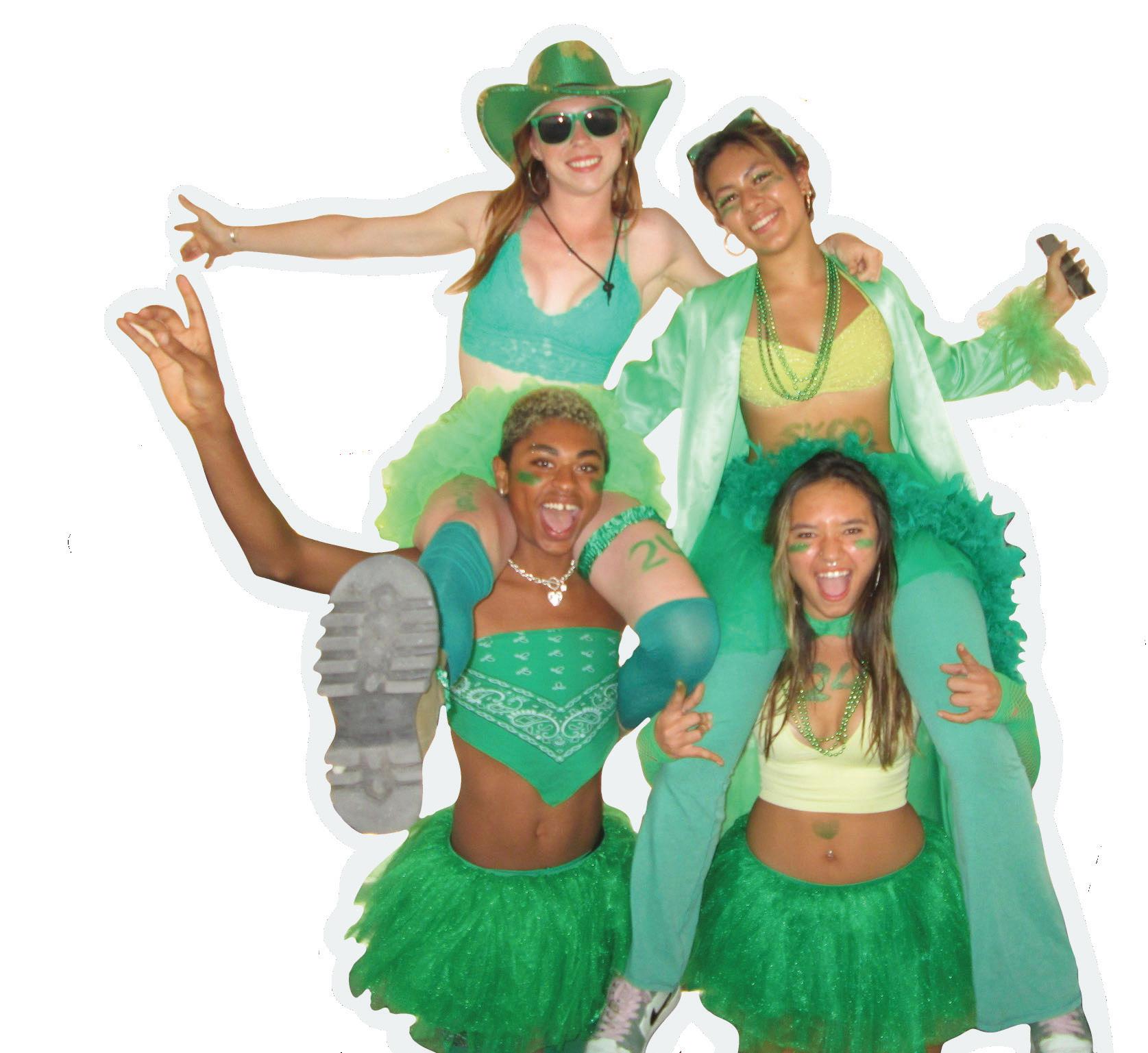
NEW THEMES
“I would really love to see Paly implement an underwater theme. There are so many ways to interpret it and make fun costumes that showcase Paly spirit.”
- Kat Farrell (‘24)


“I really wish we had a pajama theme because I think it would be so comfy to be in pj’s during a game,”
- Adi Hiremath (‘25)
“I really wish we did a western themed student section. I would love to wear my cowboy boots and hat, I just think it would be really fun.”
- Charlotte Barclay (‘26)
 photo courtesy of Hannah Jensen
photo courtesy of Hannah Jensen
 by BEAU REVENAUGH and CARTER BURNETT
by BEAU REVENAUGH and CARTER BURNETT
The HEALING GAME The HEALING GAME
Paly athletes play sports for a multitude of reasons. It could be as a way to see friends, the desire to compete, the love for a game, and even as a way to release anxiety and stress.
High schoolers are no strangers to being stressed, anxious, depressed or lonely, and each kid has a different way of dealing with these negative emotions, some good, and some bad. From dangerous extremes like experimenting with addictive drugs to healthier strategies like participating in after-school activities, to using prescription medication or therapy, every high schooler has a go-to method of stress relief.
Among these strategies, one that is often tried and true for high schoolers is working out. Exercise has been proven to be one of the most positive strategies according to psychology.
After a long day of sitting and not doing much at school, it’s fun to get outside and have some fun.
- Shalin Dwivedi ‘26
Participating in aerobic exercise naturally produces endorphins (or feel-good chemicals), improves focus afterwards, and science shows that gaining lean muscle mass can even help filter out toxins that cause depression. Exercising with friends or playing on a sports team can also provide a positive social community and working out can improve sleep, another important factor in reducing stress.
A national survey of 1.2 million Americans who were located through different sociodemographic and physical backgrounds, discovered that those who exercise expe-
rienced 1.49 (or 43.5%) fewer days of poor mental health or in the past month compared to those who did not exercise.
The data and science says it all: exercise improves mental health.
According to a Verde article in 2022, 60.6% of Paly students have participated in school sports.
While sports form an integral part of school life and culture, Paly and other local schools are somewhat unique in the competitiveness associated with academics. The cutthroat culture of Silicon Valley is brought to Paly culture from students’ upbringings. As the center of the tech industry, Palo Alto attracts the best and brightest entrepreneurs, engineers, businessmen, and other workers.
Yet the competitiveness of these people and jobs create an emphasis on students to be the best and succeed in school, graduate from a top university, and land a cushy job. While this competitiveness is not necessarily bad, it can also create pressure that leads to mental health issues for students.
Paly students pursue difficult course-loads because of the competitiveness and desire to do well in school, leading to stress and anxiety. Yet sports provide an opportunity to distract from that stress, as well as expunge it through physical activity.
Sophomore lacrosse player Shalin Dwivedi feels that playing on his team improves his entire school day by providing an outlet.
“I feel like playing a sport positively affects my mental health because after a long day of sitting and not doing much at school, it’s fun to get outside and have some fun,” Dwivedi said.
Overall, sports serve as a long-term method to achieve
EXERCISE... EXERCISE...

“Playing a sport positively affects my mood by giving a constant in my life and allowing me to work on myself.”
- Zeke Maples ‘26 (Football)
“When I’m running I feel relaxed, and I just focus on each stride and forget about all the things that are worrying me”
- Kaiden Mu ‘26 (Track)
better physical health, which is closely related to mental health. In a joint study between Seoul National University and Columbia University, mental health was plotted with respect to hours of physical activity. The study analyzed data from 7674 adult respondents from a 2008 survey of American adults. The study found that the optimal amount of physical activity to maximize positive mental health was 2.5 to 7.5 hours of exercise a week. While the optimal exercise time depends on age, gender and physical health, the study found that those who engaged in the optimal exercise time reported a healthier mental state. At the same time, sports inhibit distractions from the stresses of being a student.
Sophomore baseball player Ian Johnston feels that playing his sport allows him to distance himself from school stress.
“Playing baseball positively affects my mental health by taking my mind off of school, and is just a place where I don’t have to think about any of my stress,” Johnston said.
Working out can be taken to an extreme, where exercise becomes a detriment to the mental health of the participant.
According to Medline, a government medical information site, some people’s love of exercise can turn into a compulsion for exercise if one feels guilty for not working out, works out even if sick or injured, or, for girls, you lose a healthy period pattern.
One Paly student who wishes to remain anonymous recalls how their love of exercise became a compulsion to them.
“I just lost my passion for it,” they said. “I was turning down hanging out with friends because I still had to go to the gym that day and I was basically always sore since I didn’t give myself recovery time.”
Over-exercising can also be tied to dangerous eating disorders, and can even be caused by exercising, as the anonymous student noted.
“Playing a sport helps improve my sleep... If I don’t exhaust myself during the day, it is hard for me to go to sleep.”
- Eddrick Steil ‘26 (Football)
“I was so concerned about getting the right nutrition in order to maximize my gains in the gym that it got to a point where I wasn’t eating normally,” they said.
However, this source was able to recover their love of working out after re-evaluating their priorities.
“I realized that I wasn’t having fun in the gym anymore or enjoying spending time with my gym buddies, so I basically took a week off and tried other workouts like hiking, which was a lot more fun for me,” they said. “Right now I have been doing more hikes with my buddies and I really have been enjoying working out again, which is great.”
Playing baseball... [takes] my mind off school and is just a place where I don’t have to think about any of my stress.
- Ian Johnston ‘26
As is commonly said, the dose makes the poison. Using exercise as a stress reliever can be positive and fun, but taking it too far can have the opposite effect. On that note, too much exercise is correlated with body dysmorphia, often leading to poor mental health.
To keep exercise as a fun and healthy activity, moderation is key; make sure you’re enjoying your time with friends and feeling energized after your workouts. The incredible health benefits of exercise are something that all students should experience, so if you are ever feeling down, try going for a walk or trying some exercises in the Paly gym during PRIME.
@vikingsportsmag | MARCH 2024 | 31

Playing the
System System Playing the
By ROAN HANEY, NATHAN LEE, and ETHAN WANG
After a Paly sophomore (who wishes to remain anonymous) saw many of their schoolmates on the sports-betting app Fliff, they decided to download it and give it a try.
After getting some of the app’s online currency, they placed some bets, and earned some more online currency. Feeling like they were on a roll, they bought more online currency using real-life American dollars. The bets continued, getting riskier and riskier, until eventually they crashed, losing the currency they had bought and then some more.
“After I lost all of the Fliff cash that I bought I realized that I went too far, so I stopped for a while,” the anonymous sophomore said. “Even though I stopped [sports betting], I still see a big population here at Paly that make sports bets, and I see videos on social media all the time with jokes about betting.”
In 2018, the Supreme Court overthrew a federal ban on sports betting, allowing the state governments to set up their policies however they choose. Although there is no longer a ban on these sports
betting apps in the US, there hav en’t been any regulations legaliz ing the activities as well.
In November of 2022, Proposi tions 26 and 27 were placed on Californian’s ballots, both advo cating for a different form of legal ization of sports gambling. Both failed, meaning that sports betting of any form is still illegal in Cali fornia. California is one of just 12 states to have all forms of sports betting illegal.
Sports betting is an incredibly profitable enterprise, as much of gambling is. When propositions 26 and 27 were on the table, organizations stood to benefit billions. According to the Cali fornia Secretary of State, a com bined total of $295.5 million was raised in support of Prop ositions 26 and 27. The main contributors? Companies, casi nos, and online sports betting apps such as FanDuel.
Overall, $132.3 million was raised in support of Proposition 26, while only $43.8 million was raised in opposition. For Prop osition 27, $169.1 million was raised in support, with $249.4 million in opposition. Had the
Propositions to pass sports gambling failed in late 2022. How has sports betting in california progressed since then?

Palo Alto 32 | VIKING MAGAZINE | vikingsportsmag.com
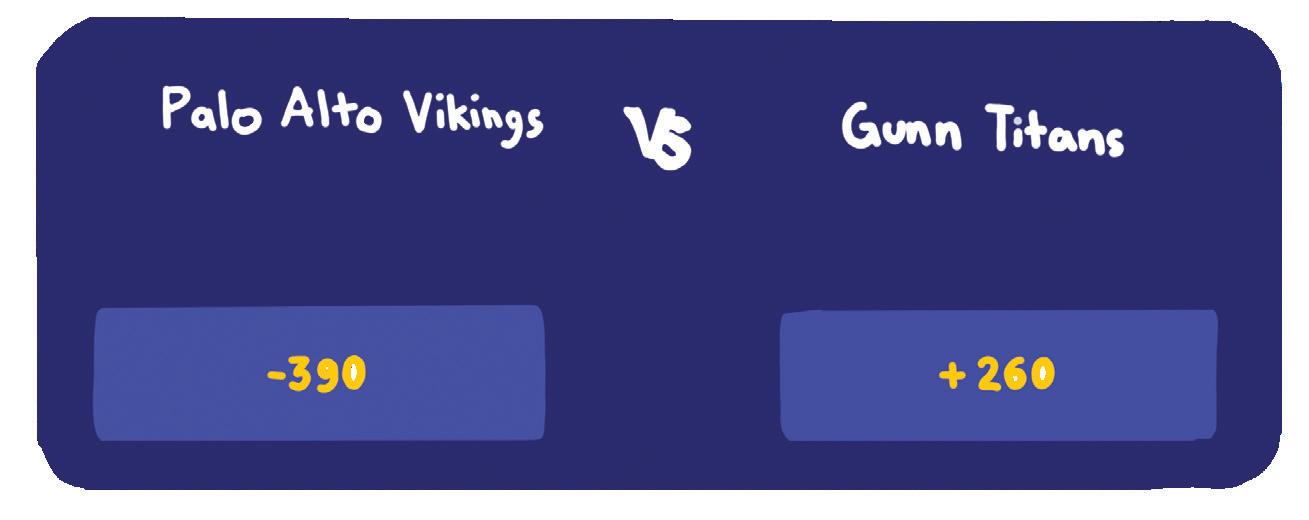
propositions passed, they would have brought in large amounts of money in taxes for the state.
Proposition 26 sought to legalize in-person sports gambling in a variety of locations. Proposition 27 took it even a step further, attempting to legalize sports betting from mobile devices, essentially people over the age of 21 would be able to place bets with real money anywhere, anytime.
At the end of the day, both propositions failed, so technically, gambling
they have found loopholes in California’s laws against sports betting,” the anonymous
source said. “You are able to win real money but you have to have a valid ID that is 21 years or older to cash out.”
Because neither are real currencies, anybody can download the app and play it recreationally. The catch comes with exchanging currencies for effective, spendable money. To withdraw fliff cash, people have to register with a real ID as over 21, and the only states that prohibit this form of sweepstakes style are Hawaii, Neva da, Idaho, Washington, and Tennes see, meaning it’s fair game here in California.

Essentially, peo ple exchange their Fliff cash for gift cards that can be used at busi nesses ranging from Taco Bell to
ty of betting online.”
Bets can be placed often and fast using the Fliff app; these apps want to remove all possible speed bumps that could cause a gambler to reconsider placing a bet. After downloading the Fliff app, it took a member of Viking a grand total of 3.3 seconds to open the Fliff app and place a random bet. A key element of recovery from any sort of addiction is placing as much friction as possible between you and a potential relapse: alcoholics avoid situations with alcohol, binge eaters keep binge food out of the house, and drug users cut off friends who use drugs. For gambling, it is the same way, and it can be seen how insidious these apps are, since their accessibility on one’s cell phone and ease of placing bets may make it more challenging for gambling addicts to recover.

Such online applications make it exceptionally easy to start sports betting and consistently keep sports betting. In 2022, Viking magazine spoke with recovering sports gambling addict Steven Delaney, who has a podcast called “Fantasy or Reality? The GPP (Gambling Problem Podcast).” Delaney notes that online gambling significantly increases accessibility and the likelihood of addiction.
In addition to Fliff, there are a number of other betting apps available to use with their separate currency.
“I can also play with my friends and compare parlays with each other. There is a fun aspect to potentially winning and having your parlays hit, especially when they have multiple legs”
-Madeleine Kuo (‘25)
These vary from Sleeper, the #1 fantasy football app with a section for sportsbooks, to DraftKings, a sports betting-focused app. All these different apps seem to be slightly different but still have the shared trait of having a sportsbook section where bets can be placed.
“I started betting on Fliff about a year ago,” an anonymous junior said. “My lifetime earnings so far are 600 dollars, and I like to believe that I haven’t wasted much of it more into betting.”
“To go to an in-person casino, you need the time and actual cash to play,” said Delaney. “With online betting, you can use credit cards and can play from anywhere. I’ve heard many people talk about betting while in the bathroom, ... in the car, even on the couch next to their spouse, and no one knew they were gambling away their life savings or going deep into debt. It’s much easier and quicker to do more damage with the accessibili -
Although some Paly students claim that they are smart with their money, others have made mistakes costing them real-life money due to the addi ctive properties of gambling, as is displayed with the anonymous sophomore source who was mentioned at the beginning.
English teacher Lindsay Cohen has never gambled but has her opinions in regard to whether or not gambling should be allowed.
“I think that any sort of gambling
Palo
Alto
needs to be well regulated,” Cohen said. “[Students] shouldn’t be able to gamble under 18.”
The most popular and simplest form of sports gambling is a money line. It is a type of bet where gamblers put money on which team or player they think will win a game. For example, betting on the 49er’s money line is betting on them to win and you’d be able to cash out if the team won.
Another common form of sports betting is point spread, where you bet on a team’s margin of victory rather than just winning or losing. A positive and negative symbol represents the spread and the team favored to win gets the minus number like (-3) winning the bet.
The last common form of betting is over-under total bets. In these wagers, you are betting on the combined points scored between both teams. For example, if the final score of a game is 21-14, the total is 35, and if you bet on that spread you’d win.
The most common form of gam bling with Paly students is bet ting with fake money because it’s the only legal version in California. These fake sports betting apps are similar to using real money and you can do the same different forms of gambling. The odds are calculated from all the bets placed.

on a sport you’re associated with.
The Football Association, the governing body over all aspects of soccer at the amateur to the professional level within its jurisdiction (England and the islands Guernsey, Jersey and the Isle of Man), has introduced a ban on betting when involved in the Premier League, English Premier, National League, the FA Women’s Super League, and The FA Women’s Championship levels. This ban is to avoid scenarios that may involve the issues that arise from the sports betting version of insider trading.
“[Students] shouldn’t be able to gamble under 18. Also, there should be a crackdown on sports gambling apps that allow students to gamble legally”
-Lindsay Cohen
The purpose of these apps is to simulate and practice the actual experience of gambling. Using social currency, you can place bets normally without the risk of losing effective cash but still have the enthralling feeling of gambling. This method is completely legal for minors in California if you don’t cash out.
“There should be a crackdown on sports gambling apps that allow students to gamble legally,” Cohen said.
However, sports gambling can be illegal in another aspect: if you bet

Palo Alto
“Sports betting on apps like Fliff is really easy because you have lots of options in terms of sports and different props to bet on”
- Anonymous (‘25)
ing permanently banned from the Hall of Fame. After all his years in the MLB and his countless awards, Pete Rose will never become a Hall of Famer due to this. This decision to this day is controversial and shows how sports betting can turn your life upside down.
Athletes included in the leagues above are prohibited from any form of betting on football locally or worldwide. In fact, Sandro Tonali, a midfielder for Newcastle, did some betting on AC Milan matches after hanging out with members of the team. As a result, he received a ten-month ban from soccer.
Sandro Tonali isn’t the one person who has been caught insider betting. In the NFL, MLB, and even the MLB, players have been caught wagering on games while active.
In the MLB, one of the most famous scandals occurred. Pete Rose, the MLB’s all-time leader in hits with three World Series, one Most Valuable Play er, and two Golden Gloves, is the defi nition of a Hall of Famer. Unfortunate ly, after retiring he became a manager for the Cincinnati Reds and just three years later he was claimed to be gam bling on his team and ended up be
In a currently unfolding scandal, Shohei Ohtani, who recently signed the biggest contract in sports history with the LA Dodgers, is in the spotlight after the discovery that his interpreter, Ippei Mizuhara (who he has fired following this news) had taken millions of dollars from Ohtani to pay off debts that he incurred through illegal sports gambling.
The story is stilll developing, and as of yet, it is unclear if Ohtani knew, or if he was robbed by Mizuhara. If Ohtani was aware, he could face serious ramifications, and even if not, gamlbing will have at least ruined Mizuhara’s life in a tragic way. As this story among many demonstrates, gambling can destroy lives.
By participating in legal gambling without the high stakes, many Paly students have found fun in playing the odds despite its addictive properties. Junior Madeleine Kuo, who participates in legal online gambling with social currencies, notices the most desirable bets are those with a higher potential

Palo Alto Palo
34 | VIKING MAGAZINE | vikingsportsmag.com
Palo Alto
Alto
your bet to cash in,” Kuo said. “The possibility of winning big is the most fun part.”
Since there are multiple conditions, the chance of winning goes down, but the rewards go up, drawing many to this type of bet.
“It’s also great because you can keep betting every day since they give you a free sum of money each day,” Kuo said.
This aspect of the “free gifts” is a tactic often employed by gambling apps to keep people coming back for more. In Kuo’s case, she isn’t risking real money, but for addicts, this tactic can be debilitating. A gift like this is called a “loss leader,” designed to entice more play.
There is also a social aspect to such apps, as they are popularly shared between friends and online. A sports betting culture has grown attached to sports fans, especially online on social media.
“A part of how I knew about sports betting was from online, for a while
I would get videos recommended to me with people talking about Fliff and different videos on it, [and] most of them were just jokes,” Kuo said.
Sports betting is just a part of the in ternet now and is something that has a massive scope from kids to older people. It is like another form of so cial media that can connect people.
“I can also play with my friends and compare players with each other,” Kuo said. “There is a fun aspect to potentially winning and having your parlays hit, especially when they have multiple legs [conditions to fulfill].”
A spirit of friendly competition is fostered between students who bet along with friends. Without the risk of real money on the line, this can be a source of fun. However, it is important to recognize that exposure to these apps at a young age increases the risk of gambling issues when older. According to mass.gov (the official website of the Commonwealth of Massachusetts), “Research shows that children introduced to “harmless bet -

at a later age. With sports gambling gaining traction around the world, more and more students have started gambling, however many don’t know the hidden dangers. Gambling, although it seems fun and harmless, after a while can cause low self-esteem, stress, anxiety, and even depression, as well as debilitating financial issues.

If you ever feel like you’re experiencing a gambling addiction, call 1-800-GAMBLER for help. $277.6 Mil by committees in support of Mil spent by committees that oppose prop 26 and 27 Prop 27: Legalizes online and mobile sports gambling for

From record breaking moments to upcoming local franchises, women’s basketball is soaring to new heights with rising stars like Caitlin Clark and Sabrina Ionescu transforming the game.
by TYLER MARTIN, MAX MERKEL, DYLAN ROBINSON and GRACE GORMLEY
art by JOSIE VOGEL

flashy.”
-Evelyn Zhang ‘24

tion about women’s sports,” she said. “They are more team-based, there’s more team-based plays and passing and everything. But people thought that women’s sports just aren’t worth watching [because] they’re not as athletic or
they’re not as interesting because they’re not as flashy. But I think people have come to realize that that’s not the only objective with the sport of basketball.”
While women’s college basketball developed less than a year after men’s college basketball (back in 1892), it took much longer for women’s basketball to become a developed professional sport, in part due to the pervasive attitudes that Zhang discussed.
The NBA was founded in 1946, but it took half a century more for the WNBA to be developed in 1996. Just like the NBA, the WNBA was making strides to do new things.
The very first WNBA game (New York Liberty versus Los Angeles Sparks in 1997) had a crowd of just over 14,000 people watching. The recent NCAA game that broke the ESPN record had more than 700 times that amount.
Sheryl Swoopes was the first player signed to a WNBA team in 1997 and throughout her career won 3 MVP awards. Along with Swoopes, many other women like Lisa Leslie – who is a four-time Olympic gold medal winner – and Val Ackerman – who became the first president of the WNBA – have made steps towards helping the WNBA thrive. There are many women who want to make the WNBA big and are putting in the work because basketball is the sport they love.

Recently, the hype and energy surrounding women’s basket ball, at both the colle giate and profes sional levels, has sky rocket ed. This is main ly in part because of more me dia coverage, for both watching the games and on social media. Through this coverage, athletes such as Sabrina Ionescu, Caitlin Clark, Angel Reese, and many more have made names for themselves through their stellar on-the-court play and off-the-court appearances.
“[Women’s bas ketball] is just getting more attention,” she said. “I think [it’s] due to so cial me dia, and how it’s so easy for mo ments to go viral. So you know, like with Caitlin Clark, she was doing so great, even in her freshman year, but she didn’t really go viral until you know, the end of her third year.”
Another Paly student, soph omore and basketball player June Tau, has loved watching women’s bas ketball since she was little and recogniz es the increase in popularity and media coverage.


“I think that the media is slowly starting to realize that college women’s [basketball] is interesting.”
June Tau ‘26
“I honestly see a great improvement within the women’s college basketball media coverage,” Tau said. “I think that the media is slowly starting to realize that college women’s is interesting. Also when big media stars such as actors, singers, and even male basketball players show their support to young college women athletes the media definitely covers it a lot.”
nament during COVID-19, the women’s side had little to no funding compared to the men’s side.
Amundsen adds how the media recently, specifically this past season, has taken a massive surge.
“I will say that within the past year it’s been amazing to see the light being shed on women’s college basketball,” she said. “There are so many talented women out there that are finally getting the attention they deserve, so I hope it continues.”
A primary example of the surge in media coverage is Sabrina Ionescu, a WNBA All-Star for the New York Liberty. She became a household name after breaking the record for most points scored in a three-point contest, between both the NBA and WNBA. At the 2023 WNBA AllStar Weekend, Ionescu totaled 37 points out of the 40 points available, and she knocked down a staggering 25 out of her 27 three-point shot attempts.
Zhang notes that the power of social media is often harnessed to support these athletes.
Laney Amundsen, a women’s basketball player for Cal State Northridge, has a unique experience with media coverage from the other side of the equation.
“From a player’s perspective, media
After this incredible performance, there was massive debate surrounding who the greatest shooter in the world is: Sabrina Ionescu or Stephen Curry? Amidst the debate, Ionescu challenged Curry to a shootout, and from the men’s three points line, no less. Curry accepted
@vikingsportsmag | MARCH 2024 | 37

such a big moment for Ionescu and women’s basketball.
“A lot of the reason that [Ionescu] is getting more attention is because she’s getting interactions with big male basketball names,” Vetter said. “I don’t know how common that is, but I definitely think that is a pattern.”
Though some believe that it’s negative that female athletes sometimes need bigger (usually male) basketball players to help give them a larger platform, Vetter thinks that this is an overwhelmingly positive scenario.
“You can see how Steph supports women’s basketball,” she said. “He takes a lot of opportunities to shout out women players. I think that’s a great move for NBA players to be doing because they [the female players] can have sponsorships, like [Stanford player] Cameron Brink has a sponsorship with New Balance and she’s getting a lot of attention. And they’re able to monetize more. So appearing in commercials with all these NBA stars is really positive.”

Steph Curry is one of many NBA players who are pushing for change in the gender inequality problem within sports. Curry helps players from the WNBA receive their deserved recognition.
Caitlin Clark is another prominent figure in the women’s basketball scene. Clark, a senior at the University of Iowa, is known for her difficult shot-making ability and deep three-point range. As a result, she is one of the most prolific scorers in college basketball history.
In fact, on Feb 15, in a game against Michigan, Clark dropped a career-high 49 points, making her career total 3,569. This number made her the highest-scoring player in women’s college basketball history, beating Kelsey Plum’s previous
However, Clark was not done yet, as on March 3, Clark brought her total up to 3,685 points, becoming the highest scorer in NCAA basketball history, both men’s and women’s, surpassing the previous record of 3,667 points set by Pete Maravich between 1967-70.
Clark’s recent surge of record-breaking has brought massive attention to her and women’s basketball, with athletes across the country giving her props and congratulating her for her success. The game in which she achieved her record collected over 4 million peak viewers and was the most-watched regular season women’s college basketball game since 1999. Numerous celebrities, including Travis Scott, were present at the game. Follow-
ing the match, Scott enthusiastically took photos with Clark and the entire team. The influx of social media posts from NBA icons like LeBron James has amplified the event’s significance, creating widespread attention and boosting its popularity to new heights.
Paly senior Neel Sharma became interested in women’s basketball primarily through Clark’s record-breaking surge.
“I [started watching] mainly because of the uprising of Caitlin Clark,” Sharma said. “She made it a situation where more people knew about women’s college basketball than men’s, and made it really relevant.”
Ever since Caitlin Clark announced she would be declaring for the 2025 WNBA draft, ticket prices for the Indiana Fever (the team with first pick, who are reportedly planning to select her) have surged. As they hold the important number one pick in the draft, it has undoubtedly in-

Joe Lacob, the team will likely be known as “the Golden State,” a name that closely ties it to their owner team, the Golden State Warriors. This is a move that is applauded by many fans who recognize the benefits of linking the two teams.
In English soccer, big club teams like Arsenal, Tottenham, Manchester City, and many more have both mens and womens teams under the same club banner, which helps increase the amount of womens fans since they share jerseys, cheers and general culture with their highly-watched male counterparts. In the case of the new San Francisco WNBA team, their close link to the Warriors might help increase the hype for the -

“I will say that within the past year it’s been amazing to see the light being shed on women’s college basketball”
CSUN basketball player Laney Amundsen
er Cathy Engelbert said the league was eyeing a short list of 10 cities for new teams and hoping to add multiple franchises by 2025.
The WNBA, which only has 12 teams in the league currently, is looking to expand the league for the first time since the Atlanta Dream were added in 2008. One of these cities which may get a new WNBA team is San Francisco, with a new team coming to join the Golden State Warriors in the Chase Center in 2025.
According to Golden State chairman
Vetter notes that the Stanford team’s popularity will alsoment for the new WNBA team. The Cardinals won theirlar season conferenceship (beforesolves next year) and are headingonships with their eyes on the gold. Their coach, Tara VanDerveer recently brokelege basketball history with 1,203 wins, beating the record previously held by former Duke men’s coach Mike Krzyzewski.
“They realize that a lot of players are getting so much attention,” Vetter said. “It’s just a good step forward, and I think they’re trying to capitalize on that [attention] and just also expand viewership, because the Bay Area has a big women’s basketball fan base thanks to Stanford.”
Zhang is hoping that the surge in popularity for NCAA women’s basketball will
lead to an increase in viewership for the WNBA as well.
“Right now college basketball is getting super popular, but the WNBA is still kind of behind the viewership,” she said. “Some people argue it’s because the WNBA doesn’t rake in as much money, and they’re not able to pay as much. But once we see big stars coming in, it’s just a matter of time.”
Amundsen adds how the recognition of college stars will help the WNBA as they make their transition from college to professional basketball.
“I would hope people continue to follow them as they take their next step to the WNBA,” Amundsen said. “This would grow the number of viewers for the WNBA.
The growth of women’s basketball does not look like it is stopping anytime soon, as there are many rising stars across both the collegiate and professional level, and the hype and coverage of the sport will continue to see an increase as well, especially as female stars gain more recognition. Soon, we could see the WNBA grow even more and hope to add more teams, eventually expanding to be as big as the NBA’s 30 teams.
The movement in women’s basketball has allowed for women’s inclusivity and growth. Women’s basketball is leading the way for other women’s sports to follow in its footsteps, further growing the foundation for women’s athletics to become as popular and respected as their male counterparts.
@vikingsportsmag | MARCH 2024 | 39
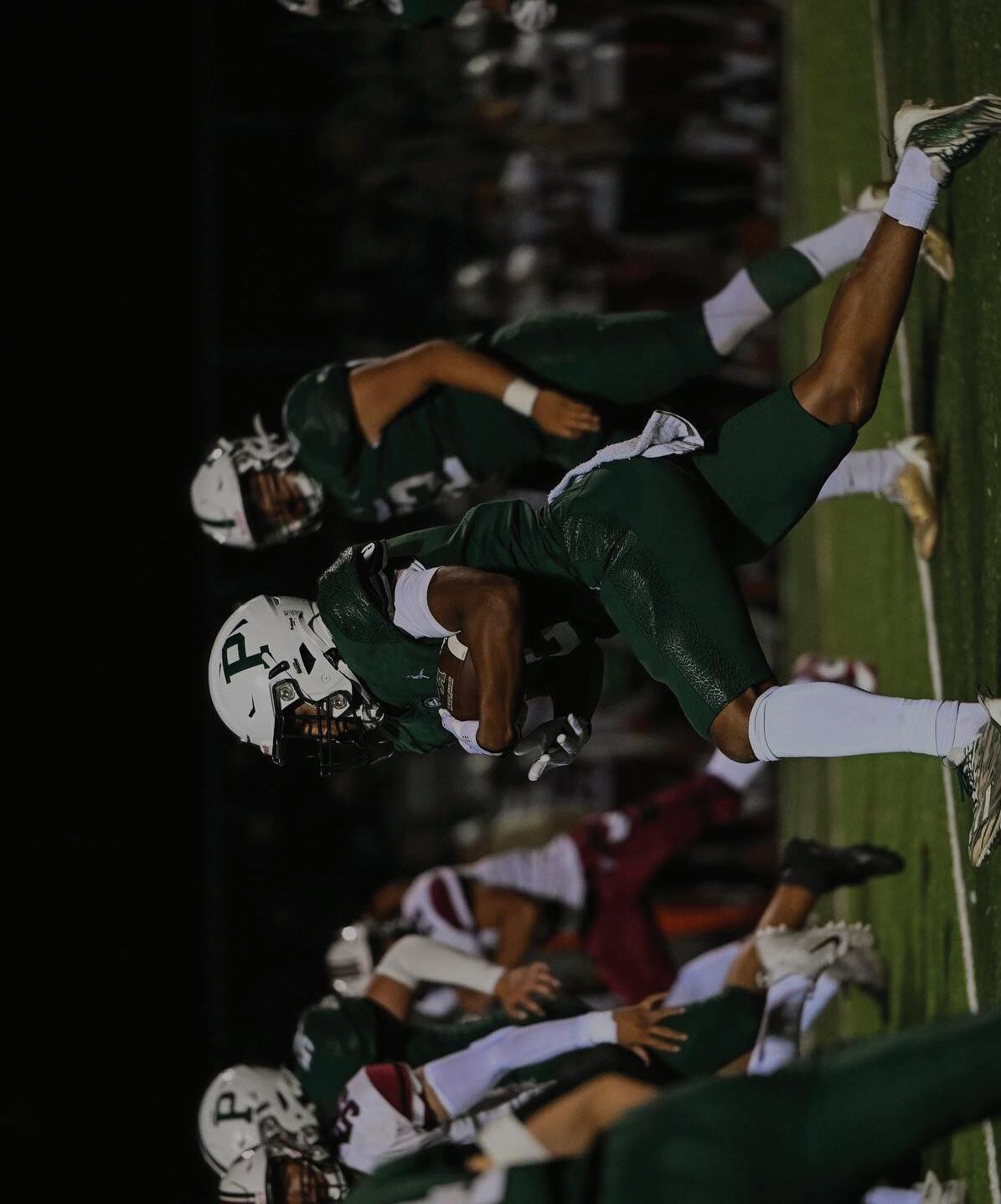
GAME CHANGER
by CLAIRE CHO, SCARLETT
FRICK, and KAMILI FOSSATI-MOIANE photos courtesy of CELESTE BATES and KAREN AMBROSEHICKEY

GIRLS V LLEYBALL
The Rule

Recently, the NCAA made a change to the way volleyball setters see the game. Stanford Women’s Volleyball Coach and Paly parent Kevin Hambly explains the change to the game.
“The rule change eliminates a double contact call provided the ball stays on the same side of the net,” Hambly said. “Basically, on first contacts and second contacts there can be double
The Thought
Hambly believes this new rule is a benefit, as the rule was a gray area before.
“We are removing one of the subjective rulings in the sport of volleyball,” Hambly said. “The reality is every set is a double contact, noone contacts it exactly at the same time. [The rule was] just up to the official to decide if it is close enough to a single contact to be ‘legal’.”
According to Hambly, the advantages seem to outweigh the disadvantages.
“One other positive, is that it will help continue play, which is better for the fans and the players, no-one really wants to have a play ended by a whistle,” Hambly said. “Let the players decide.”
While the change can be beneficial to the fans and overall flow of the game, some players like
contact and play will continue. For third or attacking contacts the old rule will apply.”
From now on, all NCAA volleyball players are now able to touch the ball twice in the same attempt on a team’s second contact, which will specifically affect the position of the setter, as they can now double-touch the ball on the second contact of the play (when they set the ball).
Paly junior setter Sophie Mies (pictured at right) are upset with this alteration, as it changes the technique they have been working at achieving for a while.
“On one hand, it’s sad for the players that have worked for a long time trying to perfect their setting and not double, which is annoying,” Mies said. “Players have worked hard not to double. But also, I never thought that doubling affected a play that much, and it takes a lot of pressure off the setter or libero when they set.”
Overall, this rule seems to be a benefit to the game of volleyball and for setters of the NCAA by speeding up the game play without significant referee interference, although it still remains confusing for others.


FIE D HOCKEY
The Rule
The now-changed rule that is found in the federation’s Field Hockey Rules Book had been carried out since 2011 and said that “players shall wear eye protection that met the ASTM standard for field hockey at the time of manufacture.” It has now been changed to “goggles may be worn by all field
The Thought
Although safety issues could be a concern, Barclay expresses her overall approval of the rule change.
“I think it’s a great rule because the goggles really obstruct your ability to play as well as you can,” Barclay said. “The goggles also limit your potential on the field, especially as a forward player. It allows players to have a better view of the field, as well as
creating better passes, better shots, and as a defender, it’s easier to see the ball to stop it.” Despite the benefits, Barclay also acknowledges the negative aspects of the rule change.
“I think there is something to be said about it [safety],” Barclay said. “It is safer to wear them because field hockey balls are really hard and it would hurt a lot if you were to get hit in the face.”
x x x x x x x x x x x x x x x x x x x x x x x x x x x x x
Ella Bishop (‘24)
Varsity Field Hockey
Sophie Mies (‘25)
@vikingsportsmag | MARCH 2024 | 41
Varsity Girls Volleyball


POLO
Water polo’s new rule is that there is a cone on either side of the pool representing a line in front of the goal that typically players are not allowed to pass unless they’re holding the ball. Entering this area without the ball will result in a turnover.
However, the new rule allows for players to pass beyond this line when far enough from the goal. Essentially, if the player is 2
The Rule The Thought
“I think that players may adjust their offensive tactics, focusing less on two-meter plays and more on dynamic movement,” Katie Spitzer (‘25) said. “Defenders might need to change their game, because they could be more aggressively marked.”
The biggest change this new rule brings to water polo surrounds a specific type of play, where the team on offense has an ad-
meters away from the cage on either side, going inside this invisible line is allowed because the angle of a potential shot is bad enough that it doesn’t provide a shooting advantage to get closer. This can create a change in how plays are arranged, specifically when it comes to structural movement, as the new rule provides the advantage of an inside look in front of the cage.
vantage over the defensive team by one player, called a six-on-five play, which occurs after a defensive player is ejected after a major foul, leaving the offense with six players and the defense with five.
“With six-on-five, it will give a team more options,” Spitzer said. “New plays can come from this, and overall the rule promotes a faster, fairer game.”
GIRLS L CROSSE
The Rule

Paly senior and member of the varsity lacrosse team Ella Bishop explains the new rule in girls lacrosse.
“One of the most impactful new rules for this season is the removal of the requirement that players stop moving after a foul has been called in their favor,” Bishop said. “This is applied unless the play
is in the critical scoring area, then it is a whistle start. Previously, you would have to stop and wait for the player who committed the foul to get behind the play.”
Basically, players are able to continue moving after a foul has been called in their favor, which keeps the game moving fluidly.
The Thought
“I think it’s a good change,” Bishop said. “It makes the game less choppy and it creates a greater advantage. You are able to use the foul to get past the defense or just catch them off guard.”
However, a benefit for the offense is a detriment for the defense.
“Of course, though, if you are the defending team that committed the foul, then it is harder to find your marks and re-defend,” Bishop said.
Bishop, a member of the Paly lacrosse team, normally plays a defense position, but finds that this rule actually helps her play instead of inhibiting it.
“I play primarily on defense and this new rule has helped me when I am transitioning the ball up to the other half of the field,” Bishop said. “I will often be fouled as I am running up and this new rule allows me to continue and get the ball out of our defensive half faster.”

x x x x x x x x x
x x x x x x x x
x x x x
x
W TER
x x x x x x x x x
x x x x x
x
Sabrina Meyers (‘27) Varsity Water Polo
42 | VIKING MAGAZINE | vikingsportsmag.com
Paly alumni Varsity Girls Lacrosse
BAS BALL

The MLB recently instituted a pitch clock set at 15 seconds with the bases empty and 20 seconds with runners on base, meaning pitchers now have a shorter window in which they must throw their pitch.
This rule change dropped the average time of a nine-inning major league game to 2 hours and 40 minutes long, a 24-min ute decrease in a season of change that resulted in a spike in batting average and the most stolen bases in nearly 40 years. This is because with less time to plan and set up for a pitch, pitchers can focus less on opponents trying to steal a base or lining up the perfect pitch.

The pitch clock was first implemented in the 2023 season, and at first, Stanton wasn’t a fan, since players had not yet adapted to the new rules.
“I was somewhat apprehensive at first, as pitchers were getting lots of pitch clock violations early in the year and it threatened to dominate the storyline of games,” Stanton said. “Very quickly, though, pitchers settled into a new rhythm, and violations became very infrequent. I really enjoyed the faster pace of the game, with less waiting in between pitches.”
Overall, the majority of baseball fans are happy with the new change, as baseball is a widely enjoyed sport, but a longer game. The new faster pace may help garner new fans and create a stronger baseball culture. Stanton points out that the pitch clock has helped eliminate some of the more heinous moments of waiting in baseball.
“There’s a pretty hilarious video of Pedro Baez of the Dodgers taking 111 seconds to throw a pitch during the 2016 playoffs,


The Thought The Rule The Rule
TBALL
The NFL recently implemented a new rule for playoffs where during overtime, both teams get a chance to get the ball so they both have a chance to score.
“If the team that gets the first ball doesn’t score, kicks a field goal, or if the score is tied after both teams possess the ball, the net score would win the game,” Paly junior and football player Joseph
The Thought
Though the rule change on the surface increases the fairness of the game by decreasing the chance of winning purely due to luck, Kessler feels that the rule change will make the game more difficult to follow.
“While I think the NFL tried to make overtime

In an age where consumers have shorter attention spans and there are more entertainment options than ever, baseball’s notoriously leisurely pace threatens the appeal of the sport. To
Tommy Stanton is a Northwestern senior and a White Sox fan, who is doing his honors thesis on the impact of the recent rule changes in baseball. Stanton shares his thoughts on the new, faster paced adjustment.
“If a pitcher doesn’t deliver the pitch by the time the clock hits 0, a ball is called, and if the batter is not ready before the 8 second mark, a strike is called,” Stanton explained.
and the clock has done away with blatant time-wasting like that,” Stanton said.
In this iconic moment, even baseball’s legendary commentator Joe Buck struggled to fill the agonizing wait, asking his co-commentator, “Kenny, would you like to fill some time here?” Fortunately, Joe Buck won’t have to worry about vamping anymore, thanks to this new rule, which also has successfully attracted more fans.
“The clock seems to have worked, too” Stanton explained. “MLB per-game attendance was up 9.1% this year, the largest increase in 30 years.”
And for Stanton, it makes watching his team, the White Sox, a bit more enjoyable; the Sox’s 2023 season was historically terrible, getting the fourth-worst score record in the majors.
“Selfishly, as a diehard White Sox fan, it made it a lot more bearable for me to watch my team play because I knew it would all be over sooner,” he said, laughing. x x x
Kessler said.
But the rule used to be that if the first team scored a touchdown, then the game would be over and the other team wouldn’t even get the chance to try and score.
“This would basically guarantee that whoever won the overtime coin flip would win the game,” Kessler said.
x
more fair, I think the rule just made it confusing for fans and more importantly, to players,” Kessler said. “But I do think the rules are much better considering it gives each team a chance to win the game.”
x

x x x x x x x x x x x x x x x
F
x
x
x
x x x x x
Jake Wang (‘26) Varsity Football

 by ALENA LOTTERER and LUKE JOACHIM
by ALENA LOTTERER and LUKE JOACHIM
The Viking Staff attempts diving, learning the deeper levels of the sports’ challenges and complexity. Diving is a niche sport that has rapidly been gaining popularity throughout the United States.
Going up on a platform dozens of feet above deep water and jumping off of it again and again may not seem like everyone’s cup of tea, but Paly’s diving team is awash with talented divers who eagerly approach the challenge of completing difficult dives to perfection. They undeniably make it look easy, but how hard is it, really?
Viking took to the board to find out in this issue’s Viking tries.
The Sport
Diving is a very niche and often overlooked sport. Requiring flexibility to get into small tuck and pike flipping positions, strength to achieve elegant flipping positions and gain height off the diving board, elegance that makes every dive look easy, and an incredible amount of bravery to conquer impressive skills and tricks, diving is a more unpopular sport. Good diving takes strength from almost every muscle in the body as well as an incredible amount of mental strength. When learning new dives with more twists, flips, and directions for flipping, fears develop about getting lost in the air, hitting the diving board, and flopping in the water.
Would the staff be able to overcome these challenges and learn how to perform graceful and difficult dives?
Viking Learns the Basics
In light of the the Paly Swim and Dive team kicking off the season and defending some CCS titles, Viking magazine staff members sophomore Scarlett Frick (swimmer and water polo player), sophomore
Sarah Thieman (swimmer and field hockey player), sophomore Amanda Goody (swimmer and water polo player), and senior Tyler Frick (basketball player) worked with Paly diving coach (and former member of the national team of Canada) Megan Parker to try out the sport.
Parker worked with the staff members to teach them four very basic dives. Our staff quickly learned that there’s a plethora of work and body control put into diving.
“There’s just so many things to think about when diving.”
bers picked up more confidence after their first dives. Each staff member started off with a front jump straight (commonly known as a pencil dive). Learning to do a proper take off from the diving board and the technique to look graceful in the air, every staff member successfully completed a front jump straight.
- Sarah Thieman ‘26
“I didn’t realize a lot of little technical things like balancing on the diving board, landing a certain distance from the board, how tight you have to be in the air, having your feet pointed and together, how to make minimal splash, and grabbing your hands a certain way just to do a very simple dive,” Scarlett Frick said.
The staff members felt overwhelmed by the amount of techniques it takes to properly execute a dive.
“Just from watching it, the divers make it look so graceful and effortless, and then doing it you realize, oh, I have to stay really tight, like squeezing your core and pointing your feet and keeping your hands tight and just lots of other little things,” Thieman said. “There’s just so many things to think about when diving.”
Staff Takes the Plunge(s)
Despite some trepidation, the staff mem-
Moving on to a front jump with a tuck position, the staff members were a little more shaky. Their first attempts were used to sort out their confusion of when (in the air) they should get into the tuck and avoid colliding with the water in a cannonball. On their second attempt, each staff member was able to develop better timing, which will prove important for when they later learn a front dive tuck, which is where you enter head first, instead of feet first.
As the staff moved on to learn their third dive, a front line-up (a dive where instead of jumping and going in head first, the diver just leans forward and falls into the water head first), they are a bit more nervous for their first head first dive.
After getting a hang of the front line-up, the staff was ready to learn a front dive straight, where the diver jumps up and dives down in a rainbow shape, a bit like a swimming dive.
“Learning the front dive felt scarier because with adding a jump to the dive, there was so much more to think about and I didn’t want to get hurt if I didn’t do
44 | VIKING MAGAZINE | vikingsportsmag.com
the proper hand position going into the water,” Goody said.
Given the importance of confidence to excel in the sport, Coach Parker comforts staff members’ fears in learning certain dives with how it’s common to experience fear in diving.
“Diving is a sport where on top of needing strength and needing flexibility, you also have to have mental toughness because it is a scary sport,” Coach Parker said.
Getting over their fears, the staff was able to perform some strong front dive straights.
“The coach gave really helpful instruction that made everything easier and broke things down well, so after I got off my first attempt, I was like oh this isn’t that bad… and when you apply the critiques from the coach it’s crazy what differences it can make, even in my very short amount of time learning to dive,” Thieman said.
To wrap up their diving experience, our staff “competed” their newly learned front jump straight, front line up, and tuck to be scored by Coach Parker. The staff showed off their new knowledge of the sport as each person was able to use the right technique for entering the water tight to make a smaller splash. While Thieman’s and Scarlett Frick’s strengths were their elegance and grace going off the board,


Tyler Frick showed good body control and Goody showed good air awareness. Tyler Frick ultimately had the highest average score, taking the victory.
Takeaways
Our staff gained many new insights on the many layers of physical and mental skills and techniques that it takes to be a diver.
“Because I’m a swimmer, I have seen diving before, but I never really thought much about the work that gets put into it and how much technique it takes,” Scarlett Frick said. “If I were to do a much harder dive, I don’t know how you’re able to think about all those little techniques and just all the nerves you have to suppress to do the harder dives.”
my dive, and just got good at that, but you have to learn many dives in so many different directions and have the confidence to do them with just one chance in the meet.”
Overall, our staff exceeded expectations on the sport and had a fun time learning all the factors of diving that aren’t super obvious when just hearing about the sport.
“Diving is a sport where on top of needing strength and needing flexibility, you also have to have mental toughness.” - Coach Megan Parker
“I thought I wasn’t going to be very great because I don’t have experience in gymnastics or anything like that, and it felt a lot harder to do the dives in comparison to watching actual divers and they make it look so graceful and effortless,” Goody said. “I wasn’t looking forward to it in the beginning, but it was fun once I had done my first couple dives and followed the coach’s instructions.”
In addition, the staff members learned a lot more just about how the sport works.
“I never knew how they had to compete so many dives,” Scarlett Frick said. “I thought you picked one dive, said that’s








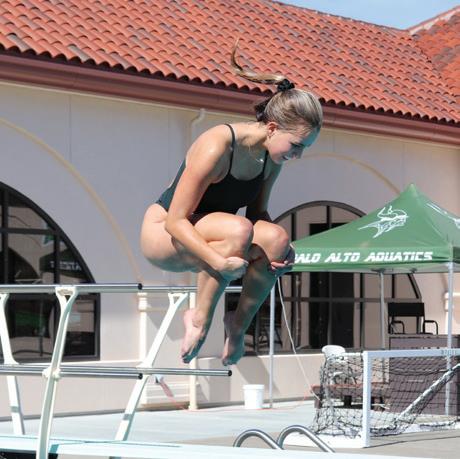
Ultimately, each of our staff members developed a new respect for diving after trying out diving. It’s a sport that looks a lot easier than it actually is after taking account of all the aspects needed to consistently get good scores.








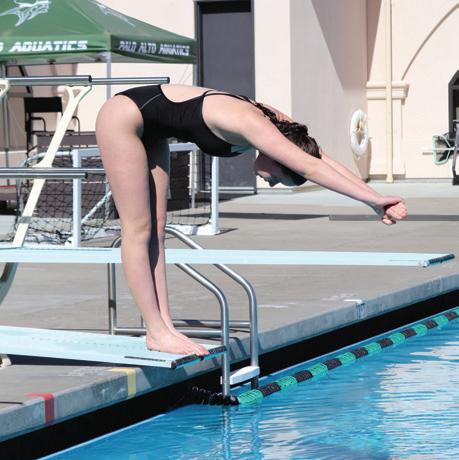

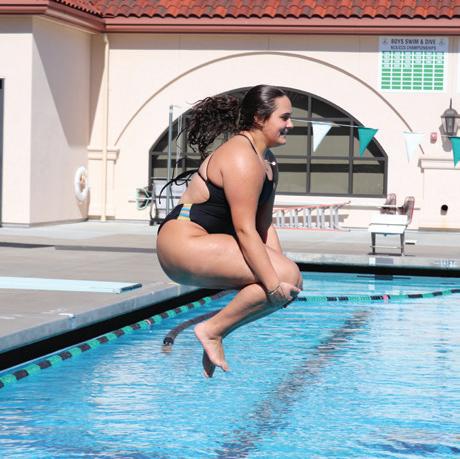



7 5 5.5 6.5 7 4.5 7 4.5 6 8 6.5 6
Pencil Rainbow Dive Front Tuck
Tyler Sarah Amanda Sarah
Inflation $uper Inflation
text by TYLER HARRISON design by TYLER FRICK
As a result of increased cap space and big markets, athletes in every sport are making more money than ever. How does this affect the free agent market, as well as player and team success?
One of the emerging trends of the 2010’s professional sports landscape was the concept of the ‘Super Team’. The term super team was used to describe teams with rosters composed of numerous superstar players. While super teams did exist previously, including teams such as the 2008 Boston Celtics, it became a much more common occurrence in 2017.
After the eventful 2016 season for the Golden State Warriors, in which they set the regular season wins record with 73 wins – but fell short in the NBA finals to Lebron James and the Cleveland Cavaliers – Kevin Durant (one of the league’s biggest stars) jumped ship from Oklahoma City to join the greatest regular season team of all time. Durant came to the Bay for the 2017 season after becoming a free agent once his contract with the Thunder was up.

contracts for a roster of superstars can be difficult for front offices, and numerous issues for the teammates and players themselves.
Average NBA player salary in 2023 $4.8 million $8.5 million
Average NBA player salary in 2013
After signing Durant, the Warriors became one of the most dominant forces the NBA had ever seen. Their success would motivate front offices across all of pro-
In the NBA, it can lead to chemistry issues, as teams have multiple players who could be the first option on offense. When you have multiple stars who all believe they should be the one doing all the scoring, be the face of every poster, and have their name in every headline, it causes issues with running a cohesive team. However, these issues haven’t stopped teams from attempting to cram as many elite players as possible onto their rosters. Nor have these issues always presented themselves. The Warriors, for example, at the height of their super team era, still had strong team chemistry
the salary cap has been increased. A salary cap is the maximum amount that teams have to spend on players’ salaries, and going over the cap will result in a punishment from the league. So in an era of historically massive player contracts, such as Cincinnati quarterback Joe Burrow’s $275 million dollar, five year deal, teams with elite quarterbacks have struggled to remain under the cap, typically underpaying their smaller-name players in order to create the most money available for their stars.
But this year owners and general managers have had more room to work with. The NFL announced that the salary cap for 2024 will be $255.4 million. This $30.6 million increase from 2023’s cap is the largest increase in the league’s history. The cap increases yearly, but a $30 million increase is extremely unprecedented. The NFL’s press release stated that the cap increase was in part to make up for payments deferred during the 2020 COVID season.
This occurrence isn’t just happening in football. According to Spotrac, the NBA salary cap sits at $136 million in 2023. As the NBA continues to rake in more and more revenue, the cap has increased steadily every single year since 2013 – oth-
46 | VIKING MAGAZINE | vikingsportsmag.com

er than a minor two year plateau due to COVID. Most notably, the cap spiked in the summer of 2016, allowing the Warriors to create room for Durant.
Increased cap and contract loopholes like this are aiding huge markets in forming super teams, and no one city is a better example of this than Los Angeles. Anytime a superstar becomes a free agent, Los Angeles teams immediately become a potential landing spot, no matter how successful the roster may already be.
Not all professional sports leagues are as lucky as the NFL when it comes to their spending limits, as the MLB’s luxury tax begins at the lower price of $233 million. The MLB doesn’t have a hard salary cap like the NFL, but rather has a ‘Luxury tax’ that is enforced when teams reach a certain dollar amount. This has led to some massive contracts in recent years, particularly one in Los Angeles.
As the MLB season begins, once again the Dodgers have somehow added another superstar to their roster, but this time in record breaking fashion, as the $700-million dollar, ten year contract given to their new pitcher Shohei Ohtani is the largest in sports history. Staying under the MLB’s luxury tax will be easy for the Dodgers though, as they were able to defer most of his money until after the contract is over. Over the next ten years Ohtani will receive only two million dollars a year. Once the ten year contract is up, he will get the rest of his deferred money, in the form of a yearly $68 million dollar payment from 2034 to 2043.
pionship winning team can be difficult for fans. It becomes a positive feedback loop: the wealthier teams buy out the biggest stars, who bring fans and more revenue with them, making the teams even wealthier.
Stephen Curry’s $201 million contract was the most expensive per year in NBA history
Joe Burrow’s $275 million contract was the most expensive per year in NFL history
I believe that players should be making as much money as possible in relation to the owners of the teams; owners make their money off of their players, and players should be compensated fairly. While it may seem unnecessary for players to earn insane amounts of money, I believe that they deserve the majority of the revenue
generated from their work. At the end of the day, the athletes are the main reason these leagues are growing at the rate that they are. Lamar Jackson may have signed a $260 million dollar contract for only five years, but who in the Baltimore Ravens’ organization would be more deserving of that money than the two time MVP.
Contracts may continue to get more and more outlandish, but the power still truly belongs to the players. Hopefully star players can still sometimes prioritize helping a team grow and develop together rather than bouncing around their respective leagues chasing their next payday or shot at winning a championship.
In my opinion, the opportunities for super teams and massive contracts now presented by larger cap and contract loopholes have both positive and negative effects. The negative aspects of these trends are that teams with the biggest markets like the Dodgers, Yankees, or Cowboys now have the opportunity to monopolize the free agent market. Watching as the richest franchises in their respective leagues throw incomprehensible amounts of money at star free agents in hopes to build a cham-
$134 Million $63 Million 2015 2024 NBA Salary Cap by Year (data from Statista)
PALO ALTO UNIFIED SCHOOL DISTRICT
PALO ALTO HIGH SCHOOL
50 EMBARCADERO ROAD
PALO ALTO, CALIFORNIA 94301



Non-profit Org. U.S. POSTAGE PAID PALO ALTO, CA Permit #44
Freshman Hannah Oh chases down a Los Gatos swimmer in the 100 yard breastroke during Paly’s meet against the Cats on Friday, March 15, 118-67. Photo by Grace Gormley.


















 Photo by Grace Gormley
by AMANDA GOODY and JONATHAN YUAN
Photo by Grace Gormley
by AMANDA GOODY and JONATHAN YUAN









































 text and design by EMIL BOTHE, TREY COLLINS, and EVIN STEELE
text and design by EMIL BOTHE, TREY COLLINS, and EVIN STEELE




 Photo courtesy of Keshuv Srinivasan
Photo courtesy of Keshuv Srinivasan












 The premier of Polly’s film in Menlo Park. Photo courtesy of James Polly
The premier of Polly’s film in Menlo Park. Photo courtesy of James Polly










































 photo courtesy of Leilani Chen
photo courtesy of Tate Hardy
photo courtesy of Leilani Chen
photo courtesy of Tate Hardy




 photo courtesy of Hannah Jensen
photo courtesy of Hannah Jensen
 by BEAU REVENAUGH and CARTER BURNETT
by BEAU REVENAUGH and CARTER BURNETT




































 by ALENA LOTTERER and LUKE JOACHIM
by ALENA LOTTERER and LUKE JOACHIM



















